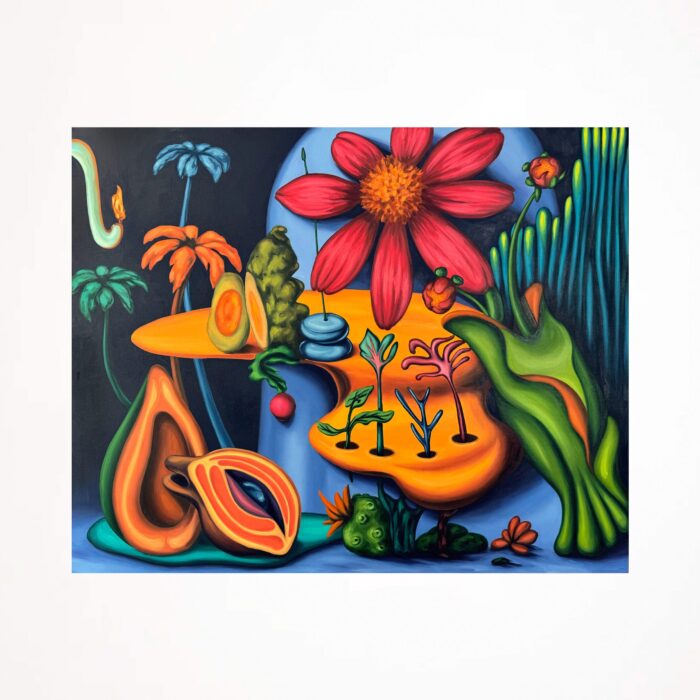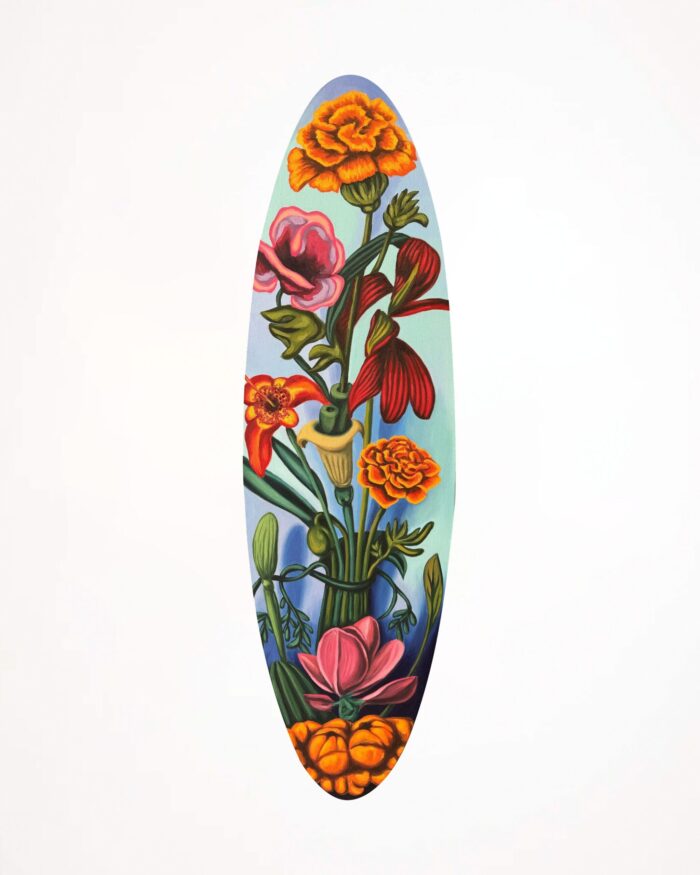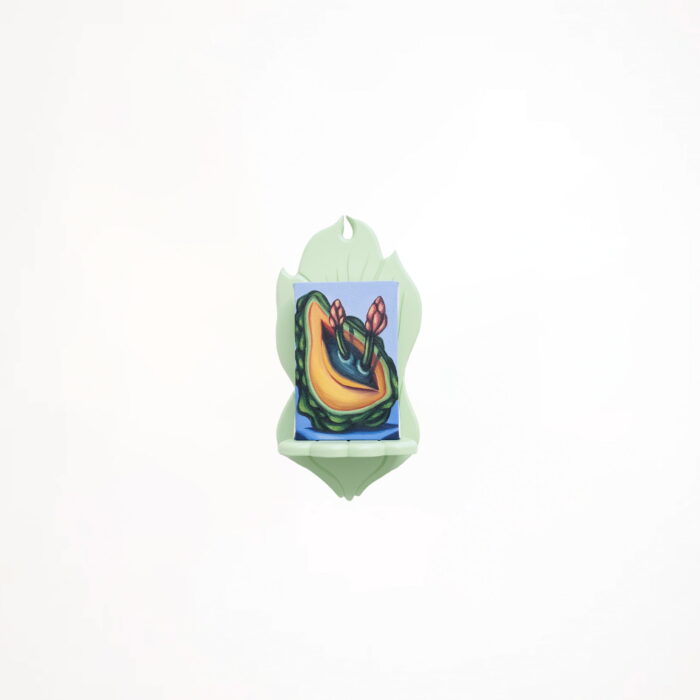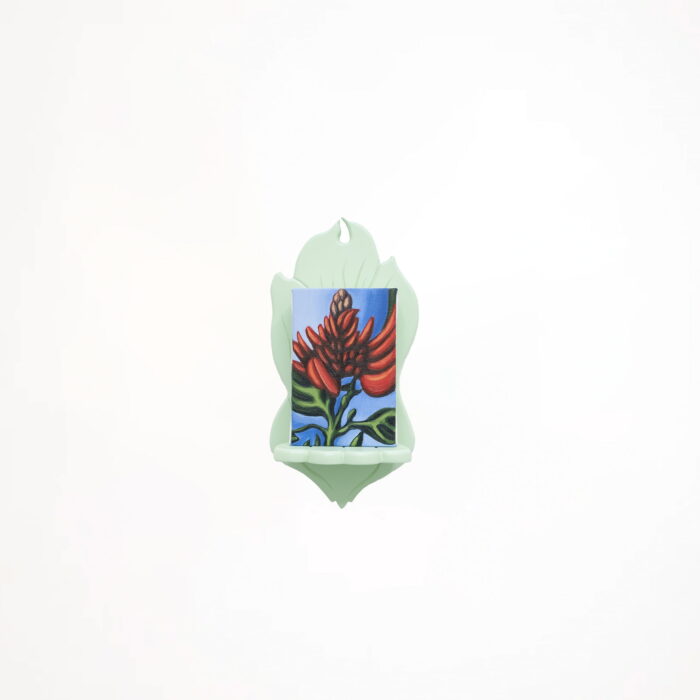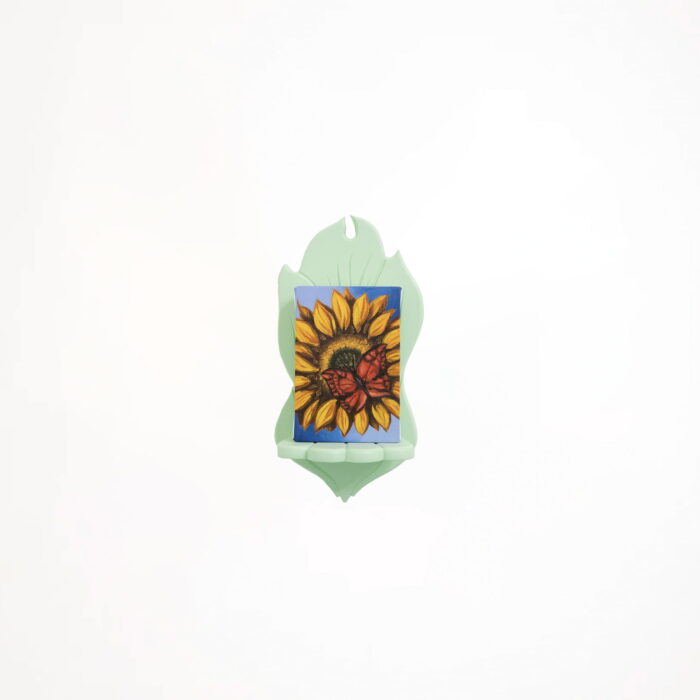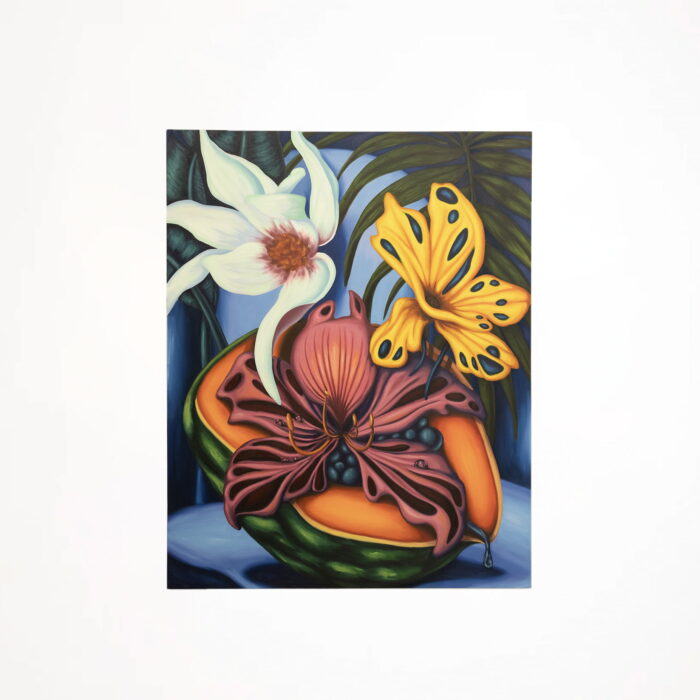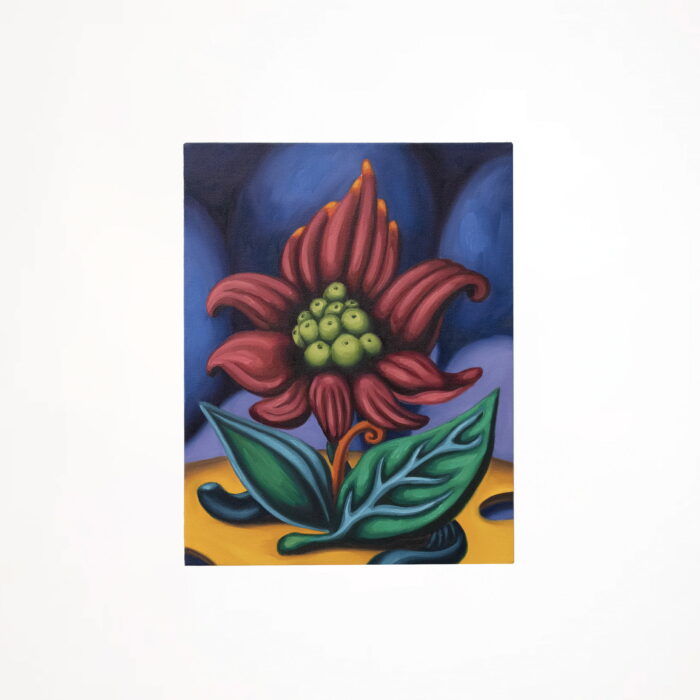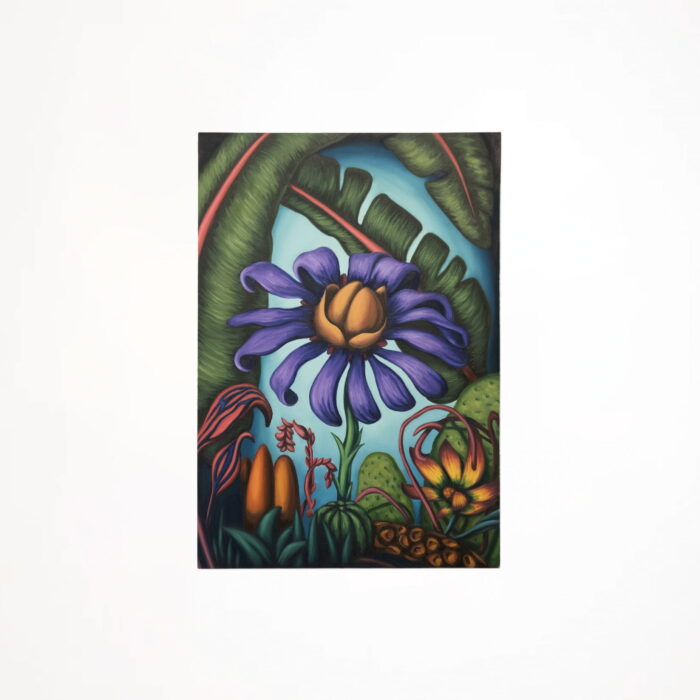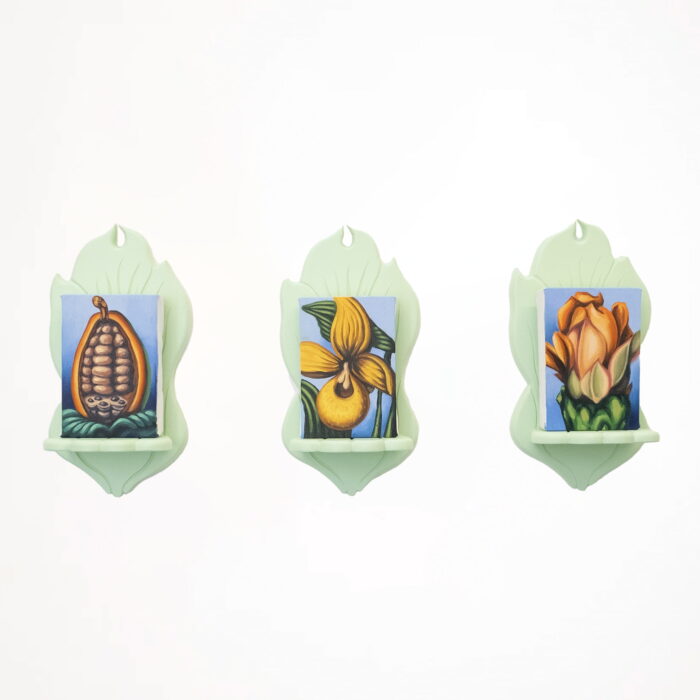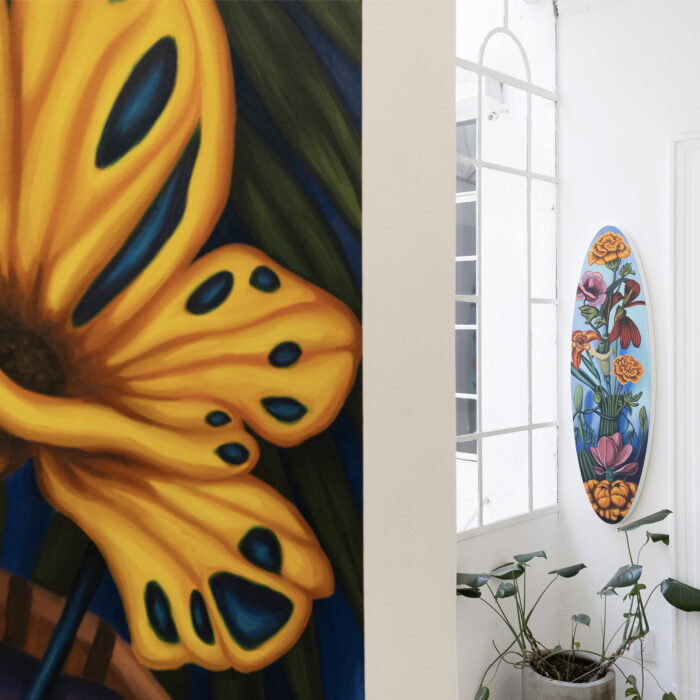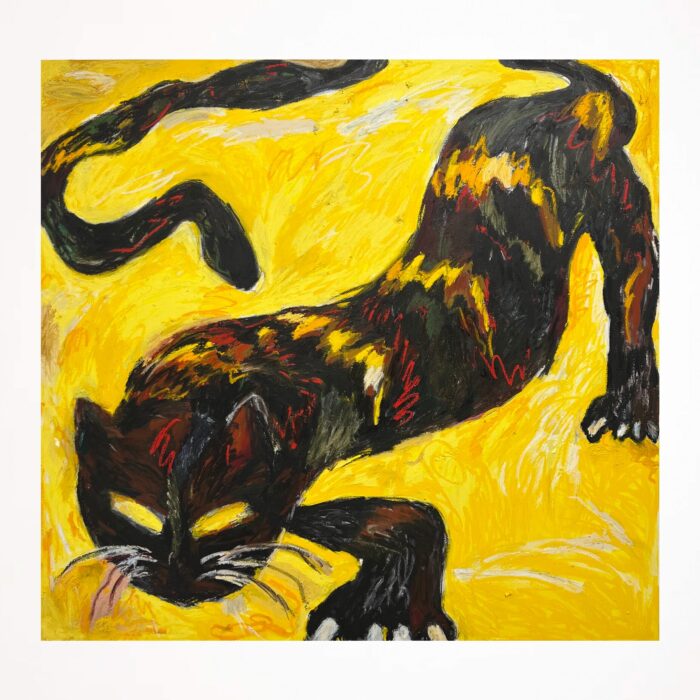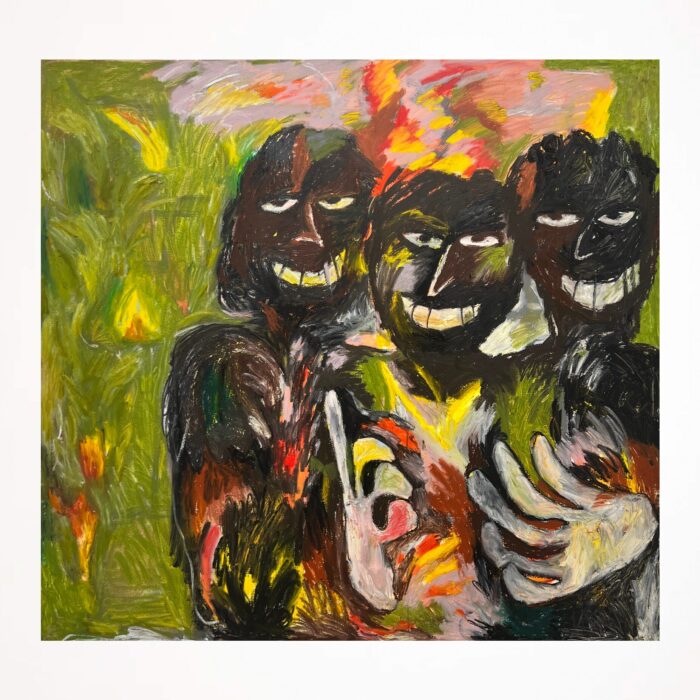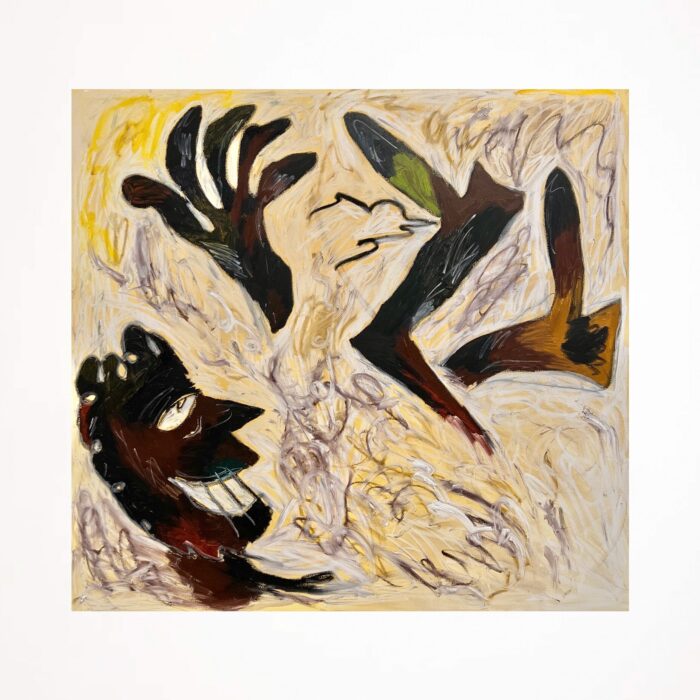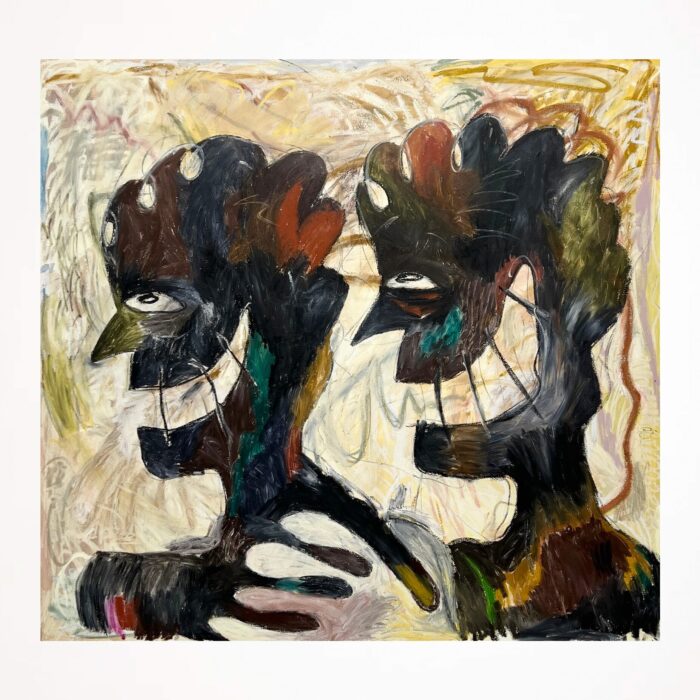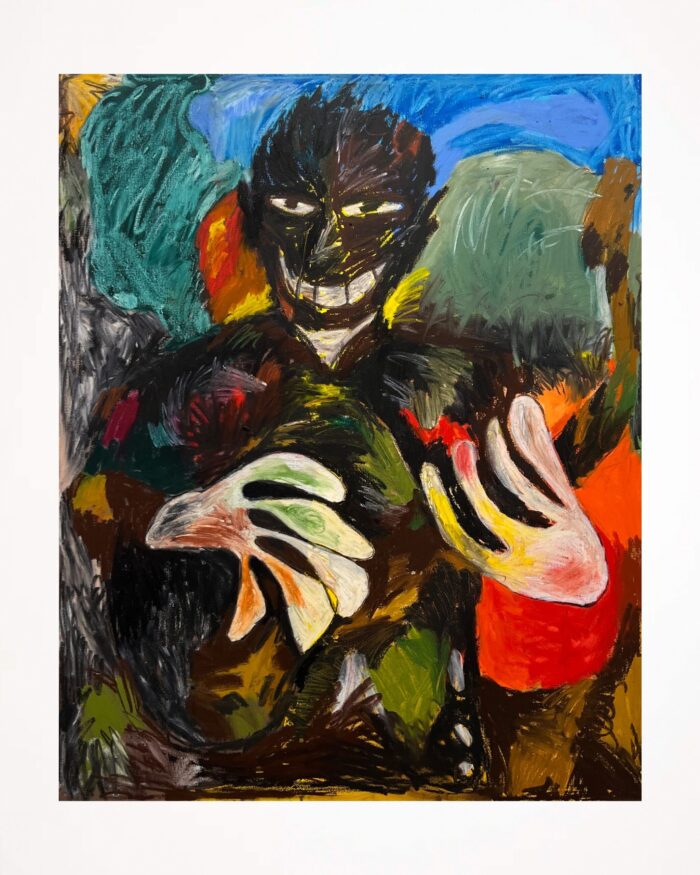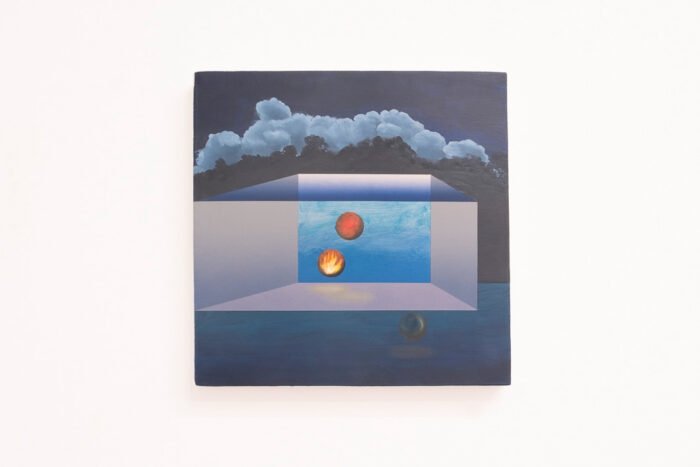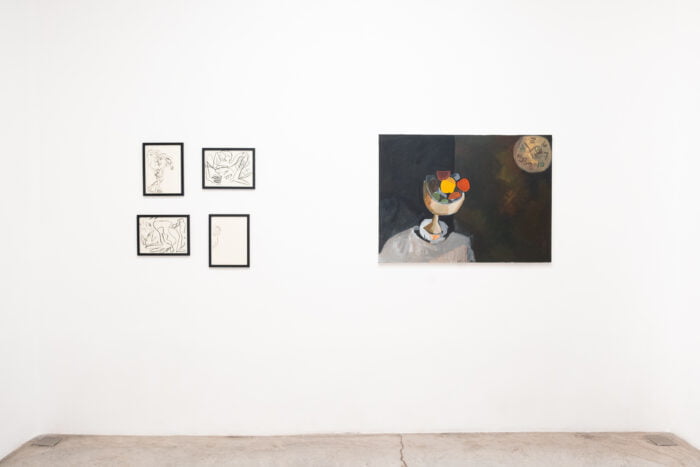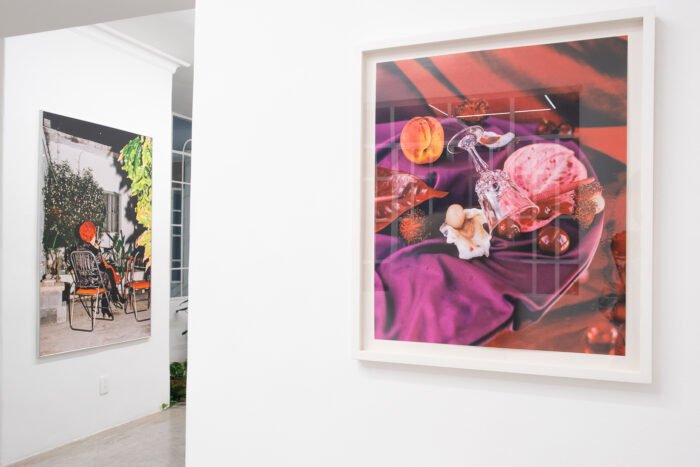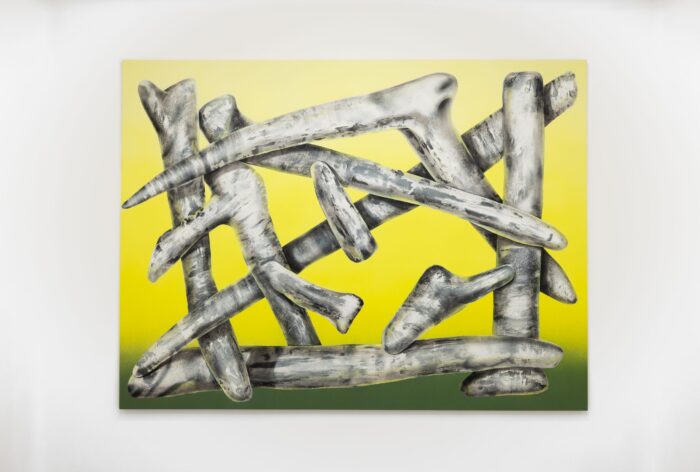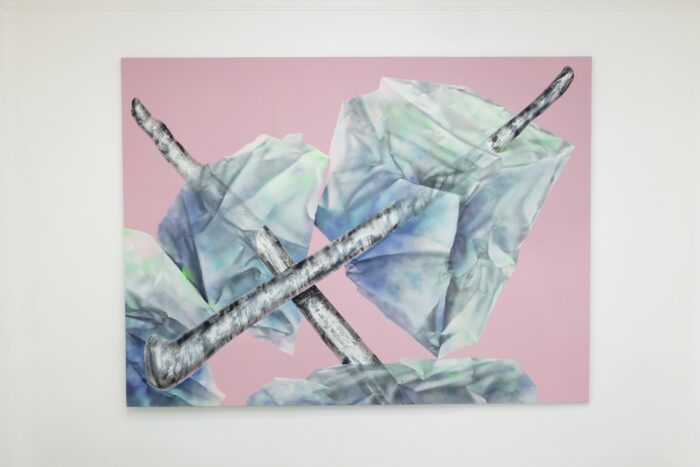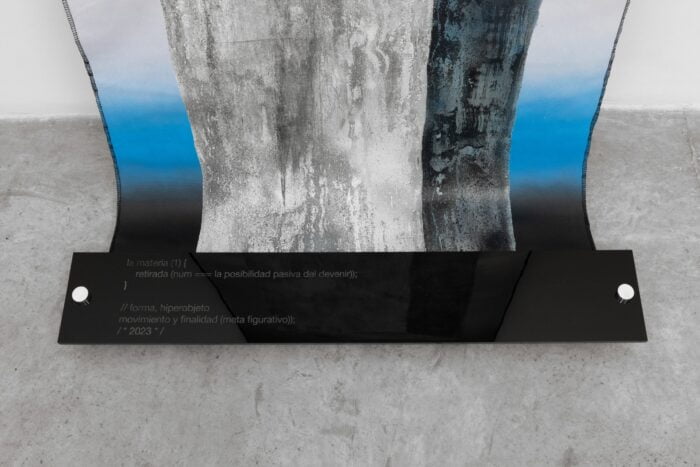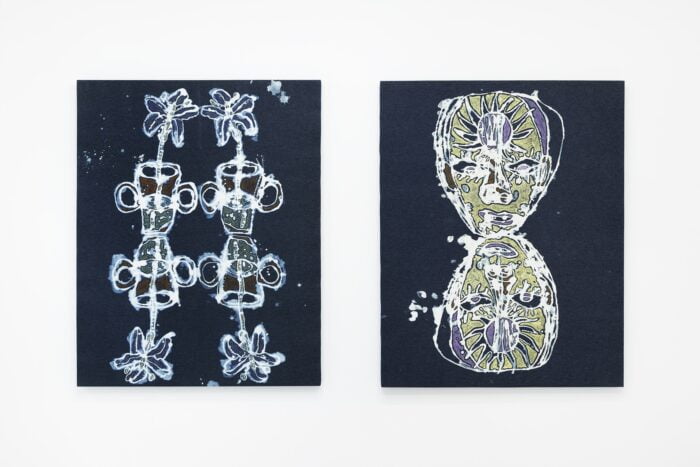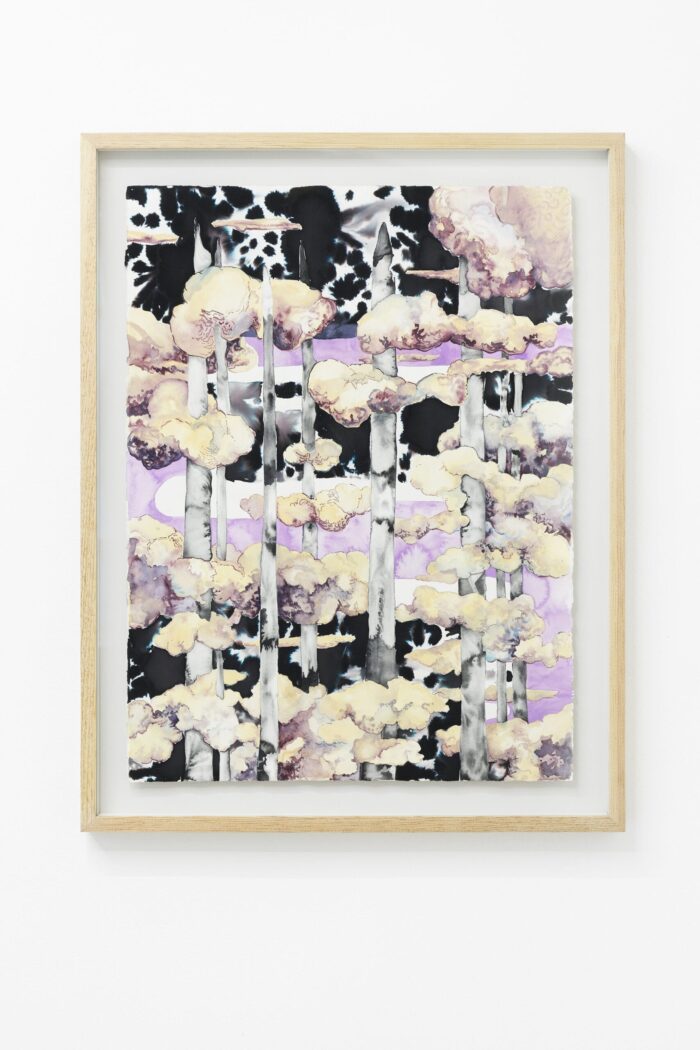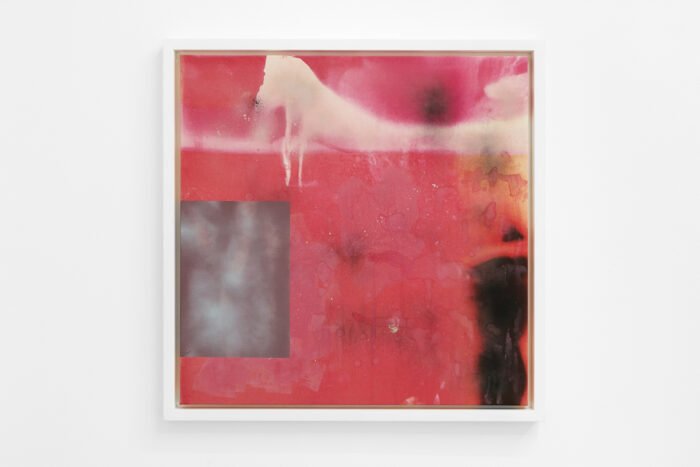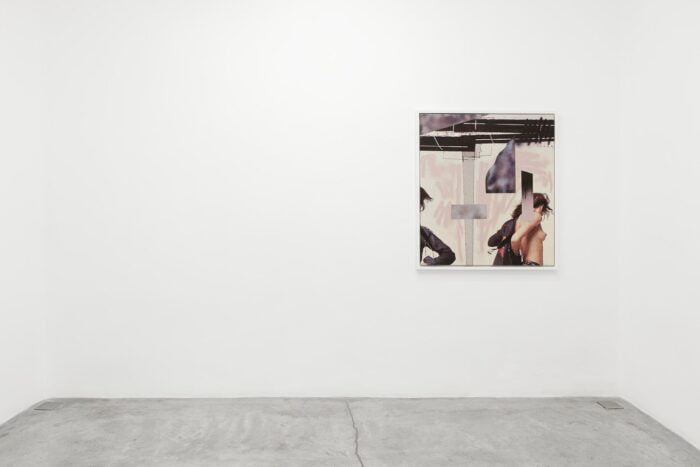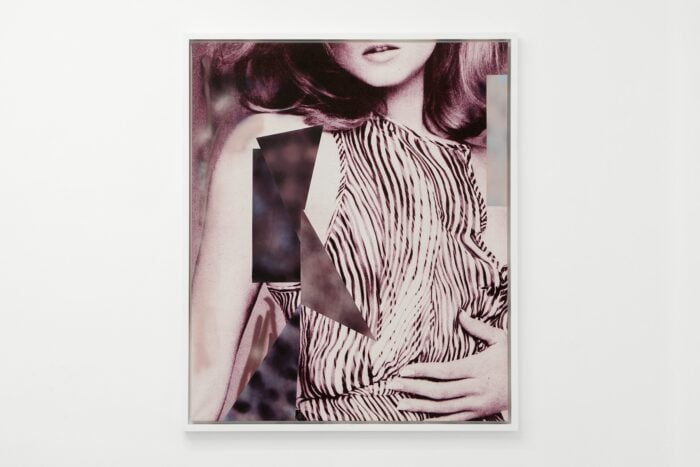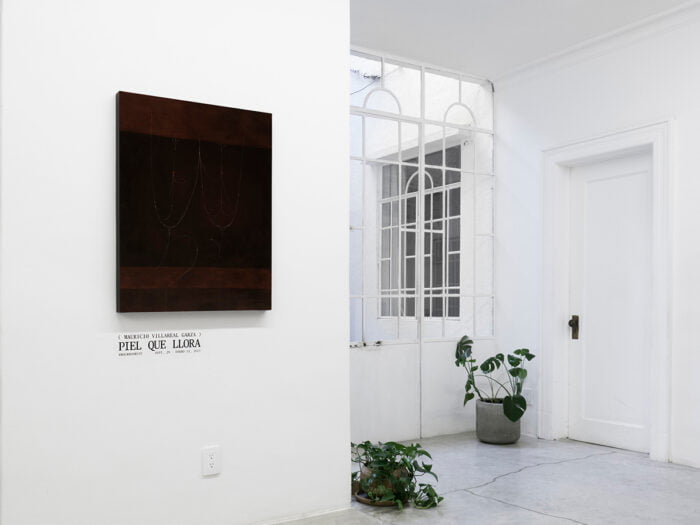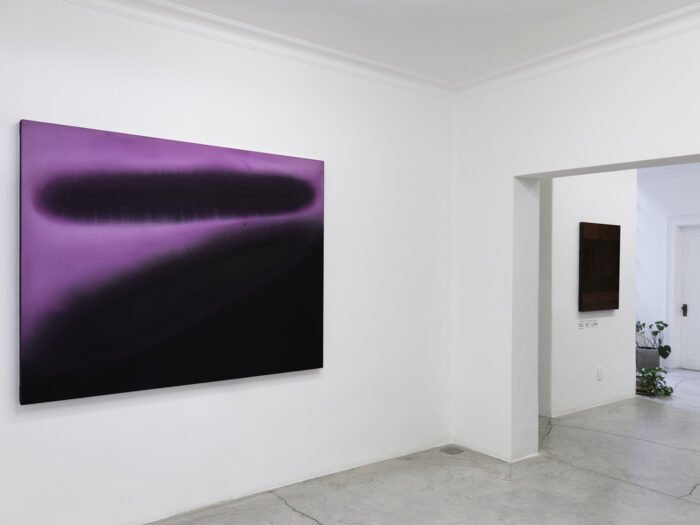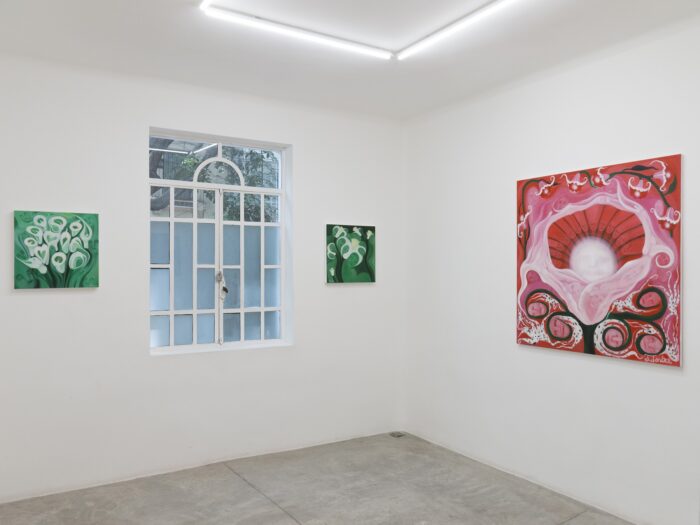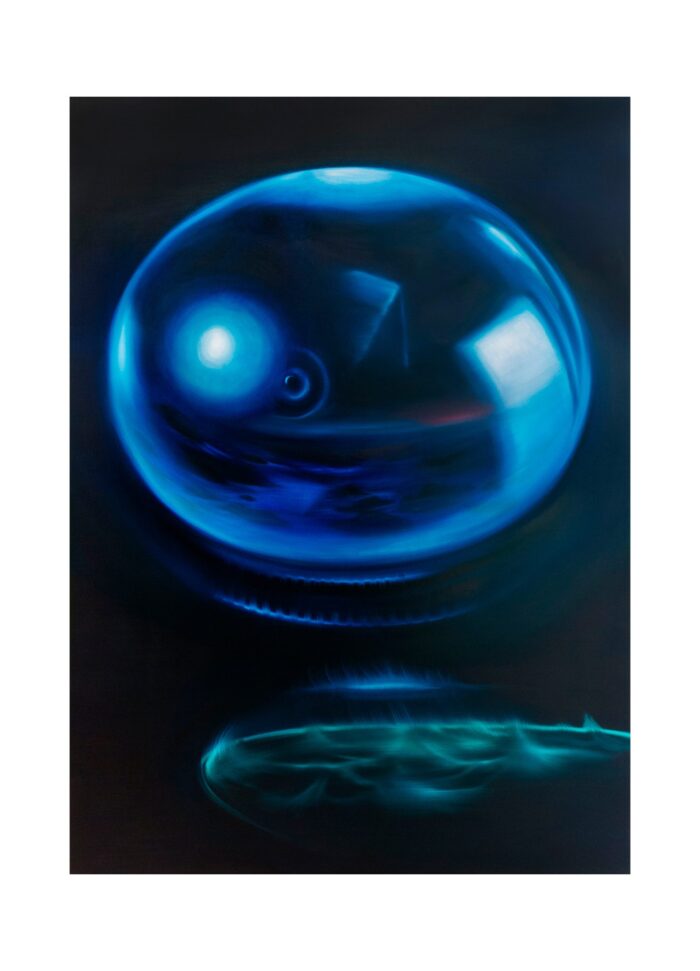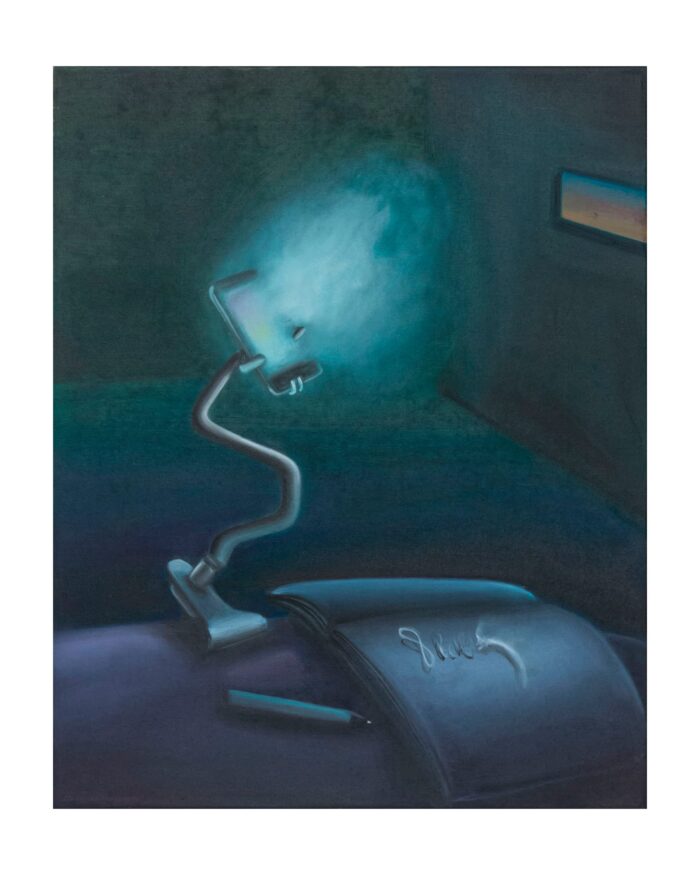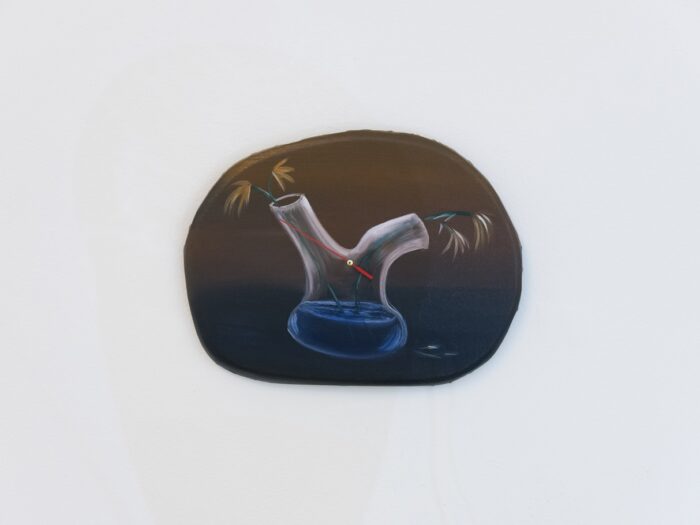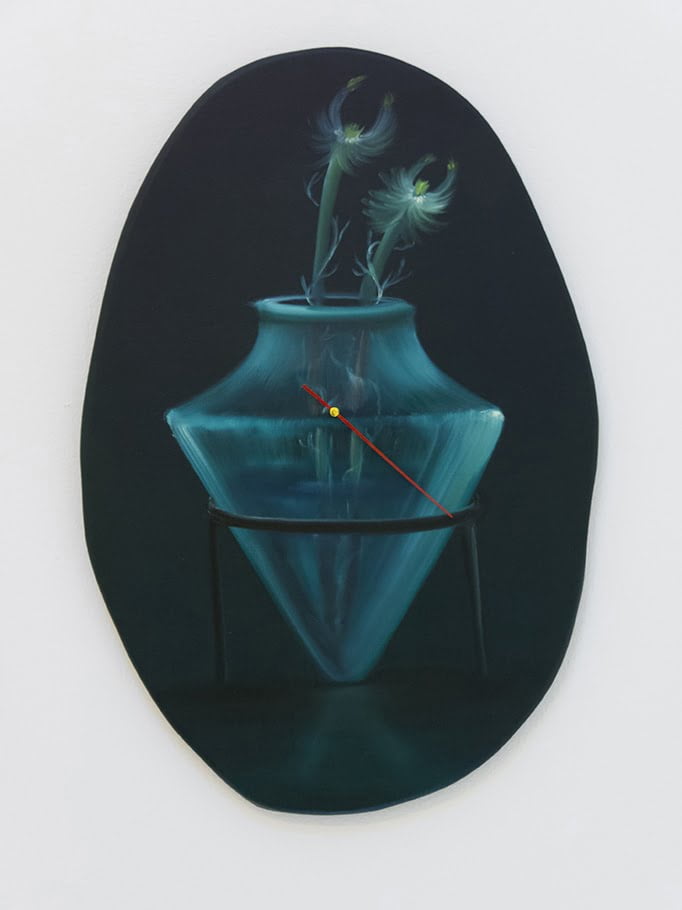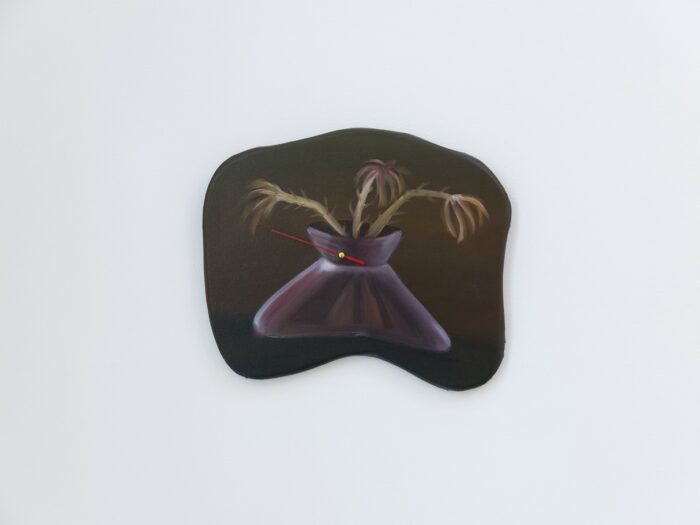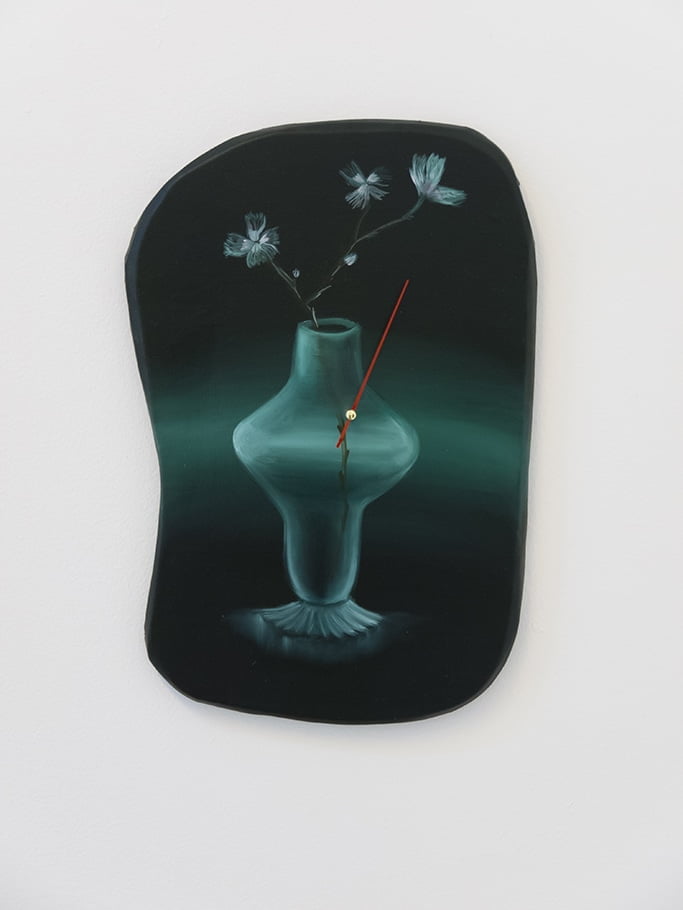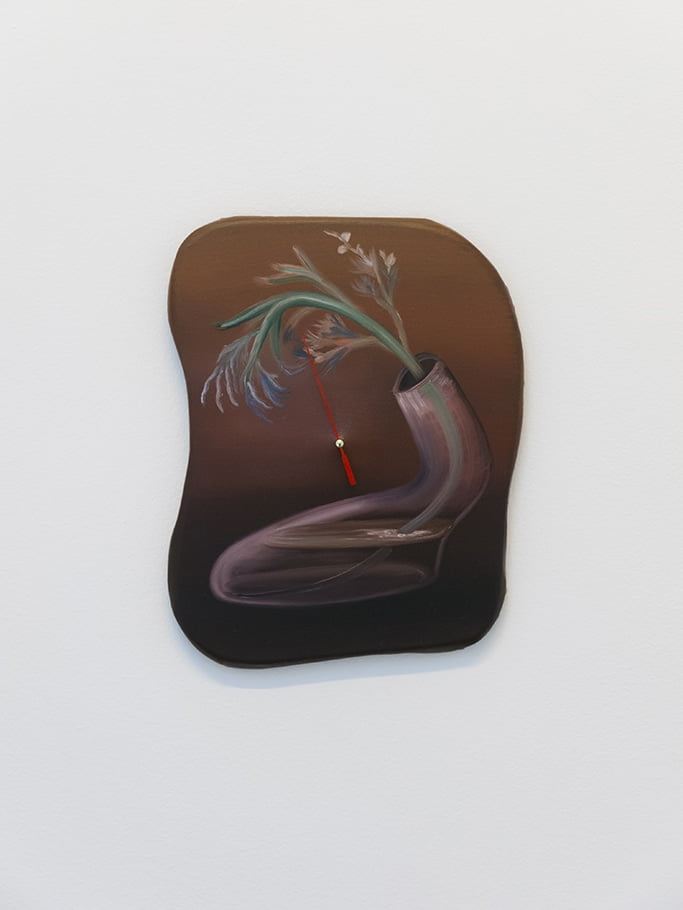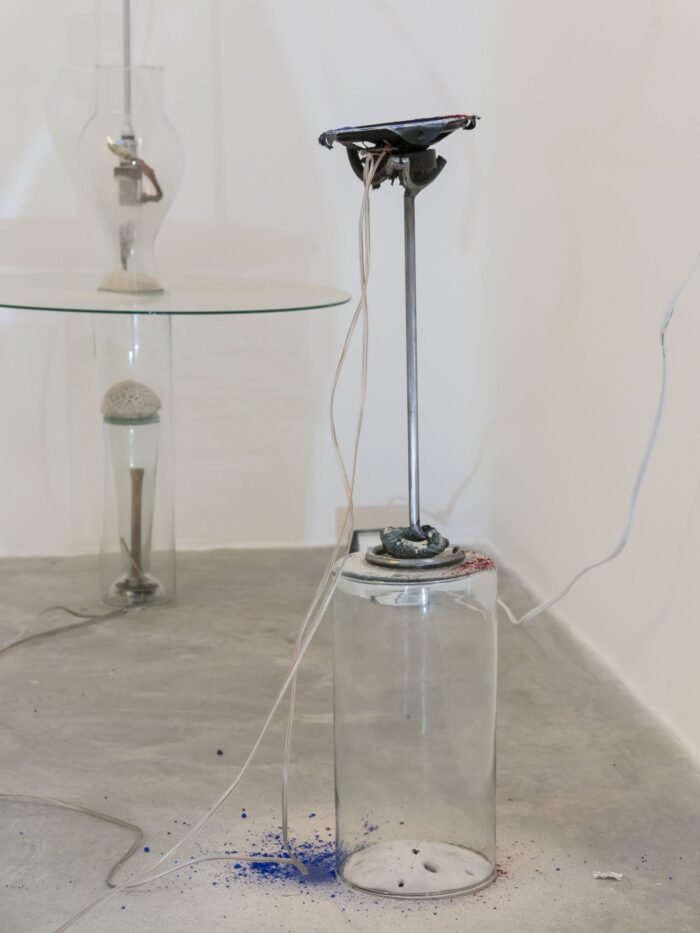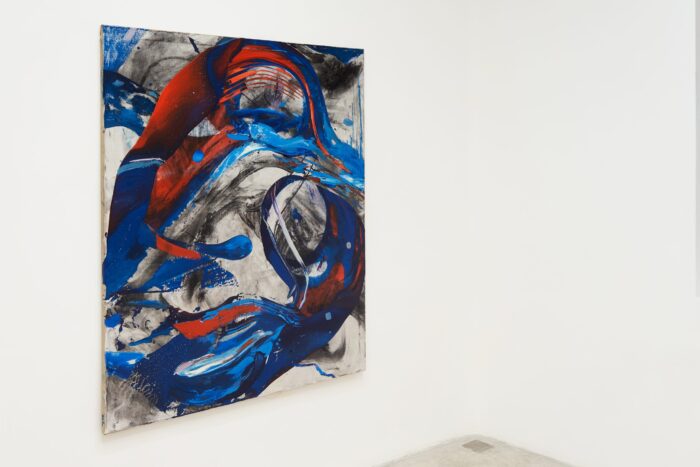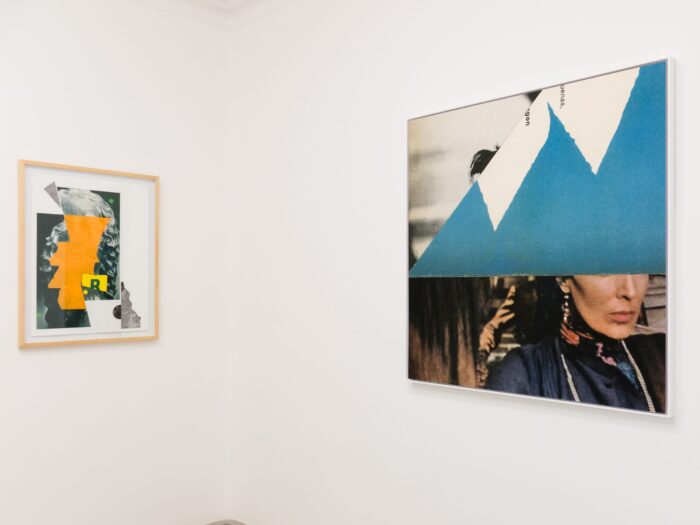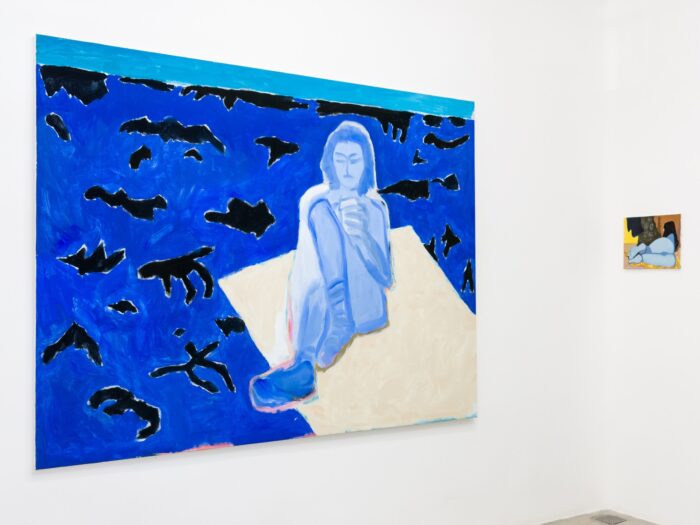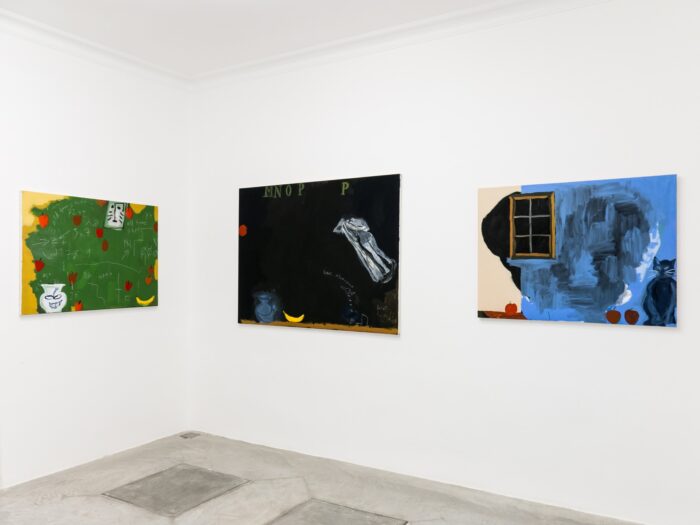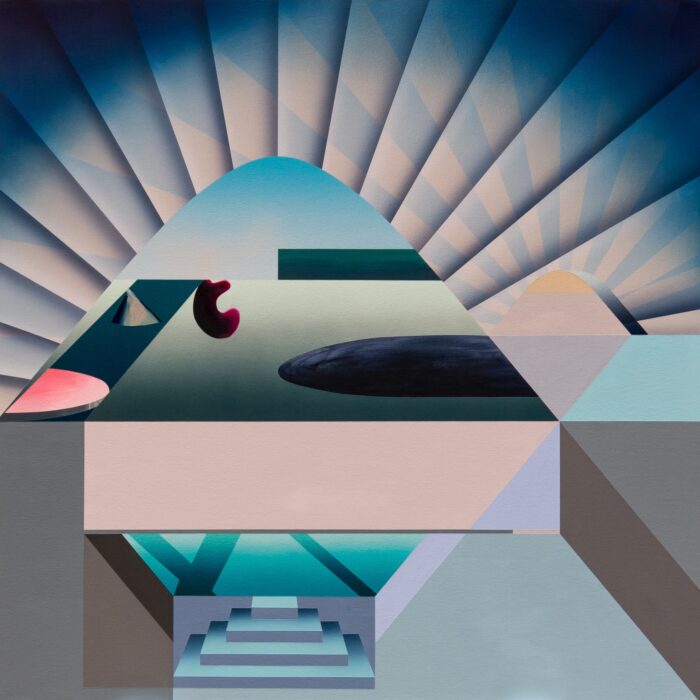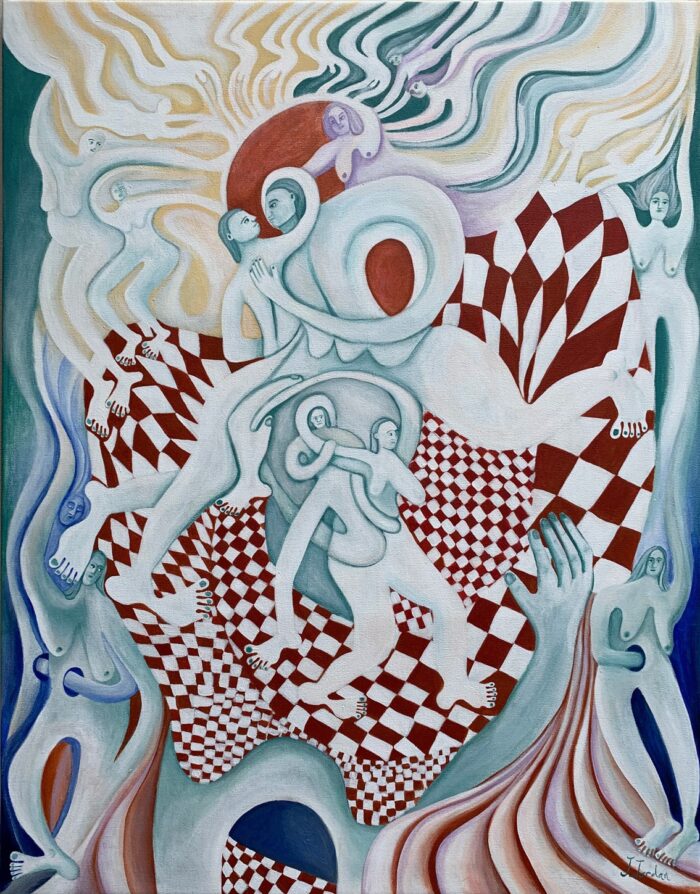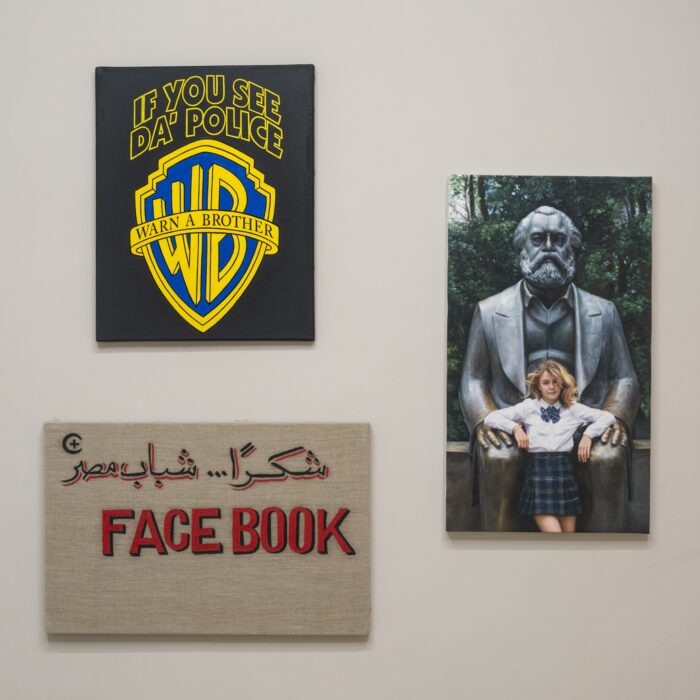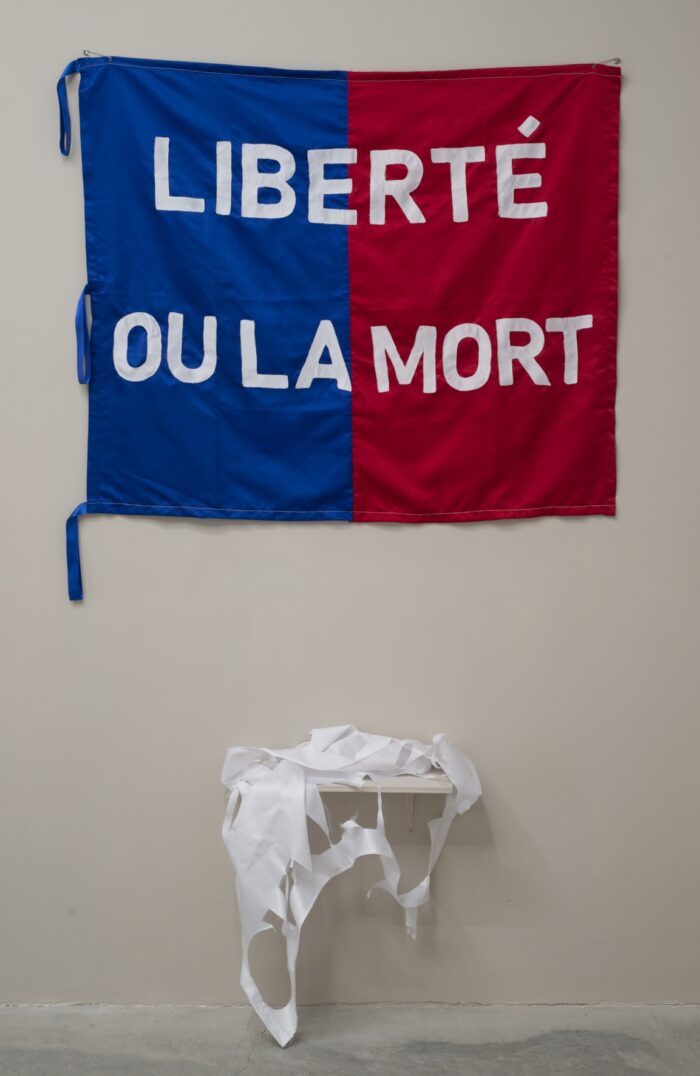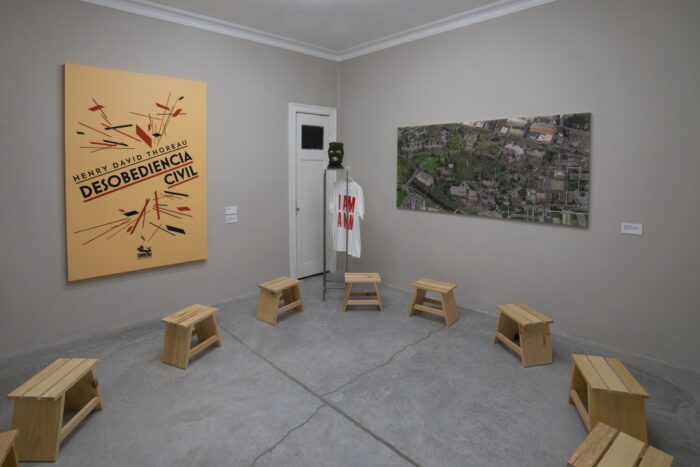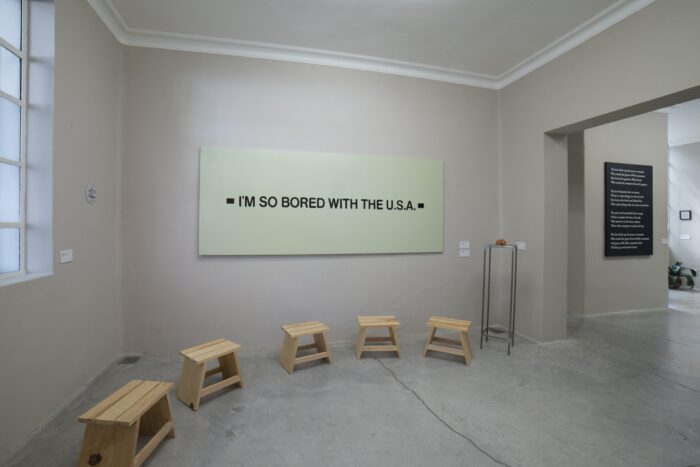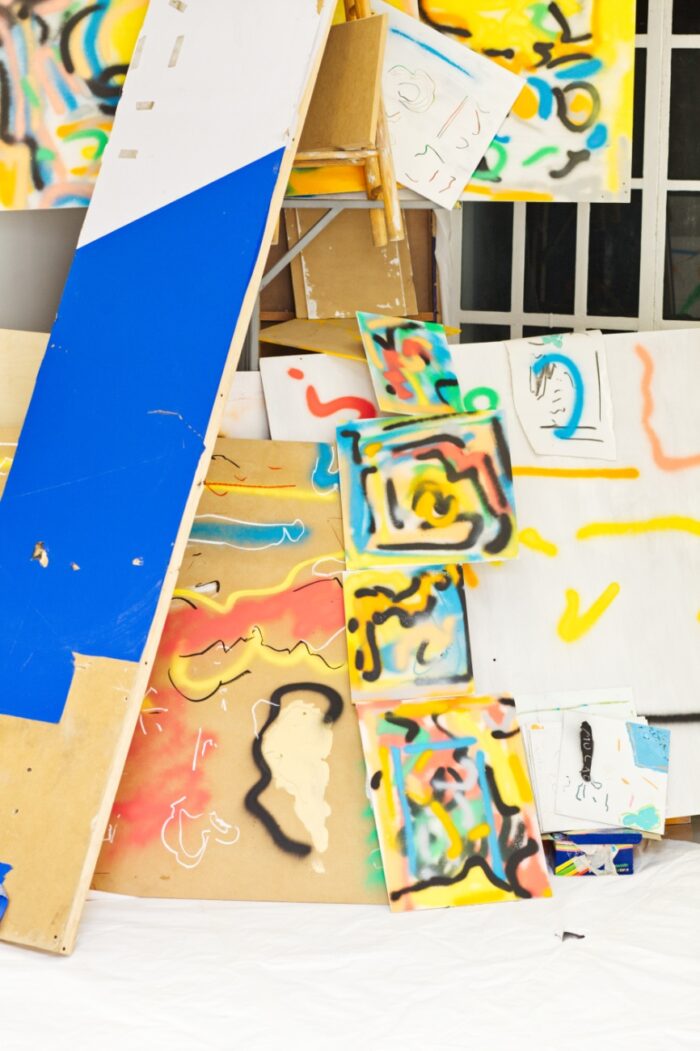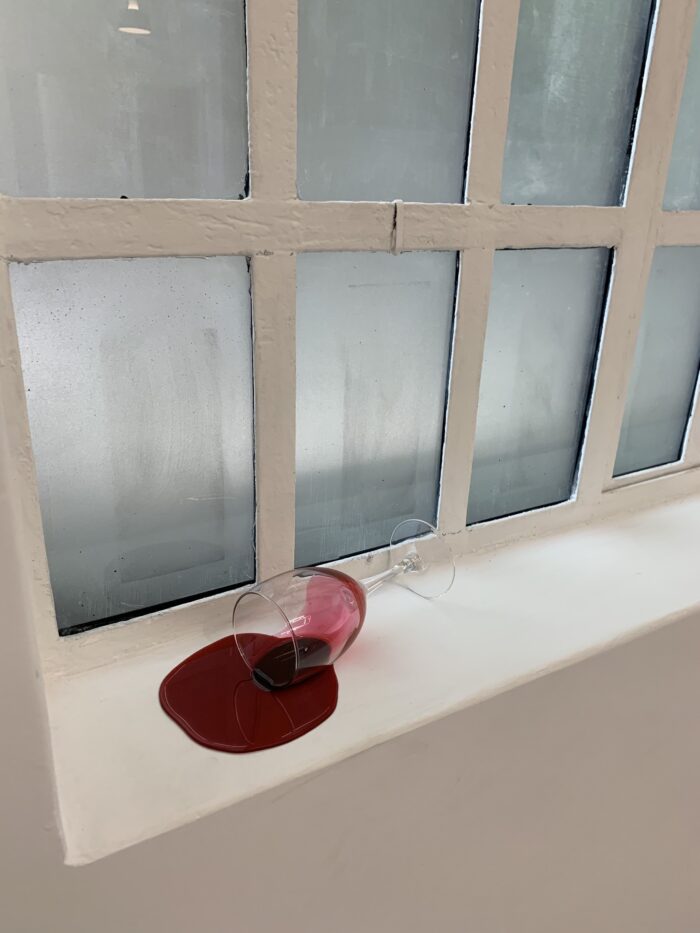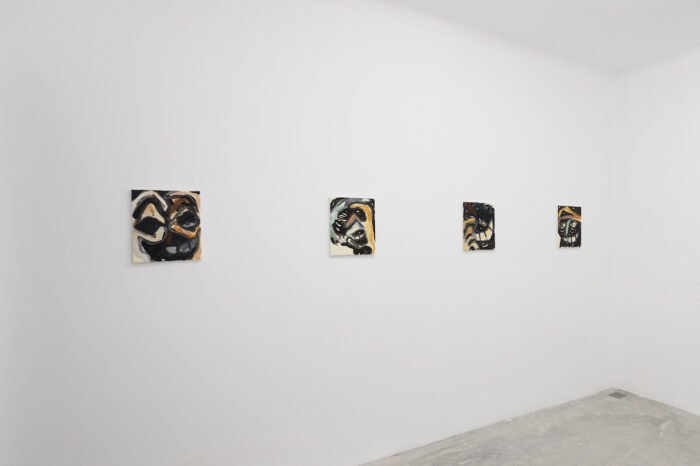OFRENDA
KORA MOYA ROJO
09.05.24 – 19.07.24
Acerca de:
The gallery is proud to present the first solo exhibition of Kora Moya Rojo in Mexico. Kora is a Spanish painter, whose work revolves around fluidity, nostalgia, and nature. Through the reconstruction of dreams, imaginations, and memories in enchanted drawings and canvases, Moya Rojo creates mysterious worlds that inhabit the liminal space between the conscious and the unconscious.
For this exhibition, Moya Rojo takes as a starting point the country’s endemic flora and religious symbolism. The artist presents us with a place of comfort that takes us back to nature in a transcendental journey.
TODAS PARTES
RICARDO GONZÁLEZ
02.03.24 – 04.26.24
About:
Daniela Elbahara is proud to present “Todas Partes,” Ricardo González’s 3rd solo show in the gallery. Thoughtful about trajectory, we celebrate the Mexican painter’s mid-career and our 5th-year anniversary.
These new sets of oil paintings were recently produced in Mexico City, where the artist relocated temporarily from New York. His current studio is around the neighborhood where he grew up, and in a sense, he has been reconnecting with his early motivations to make art. This project has also been an encounter with his childhood “shadows” that might be lurking in his present background.
The paintings are made in a manner in which the emotive hand is omnipresent in the strokes and in the dynamism of the images. Looking closely at the works, there is always a hand or hands as if reaching out for something or grasping to keep things together. The richness of oil paint, with its empasto and ever-changing sheens, gives the works an empowering charge in which these “shadows” can exist to remind the viewer of their presence.
“These shadows are hidden parts of ourselves that are always present, lurking in the background, looking back at us smiling as if inviting us to accept their inevitability. They are not necessarily “bad” or “good,” which is why they present themselves both charming and menacing, depending on the viewer’s judgment or projection. These “shadows” appear gathered together or by themselves smiling at the viewer. Sometimes they are completely fragmented, floating around as an abstract shape, and other times they manifest in the shape of a black cat staring out at us.”
The title refers to these dark entities being in all of us; we all carry our own and as well as in society as a whole, like Carl Jung’s idea of the collective unconscious. These are our impulses, our manias, our desires, and motivations coming from the deep dark sea of our being.
“His is a journey marked by the questioning of experience itself, until what is reached is sovereign laughter, non-knowledge, and a Presence in no way distinct from Absence, where the mind moves in a strange world where anguish and ecstasy coexist.”
Georges Bataille, “Inner Experience” (1943)
When the tide goes out and the mist disappears
Collective
11.16.23 – 01.19.24
About:
Daniela Elbahara Gallery presents the collective exhibition “When the tide goes out and the mist disappears.” In this showcase, the infinite and subjective complexity of the artists’ intimacy is explored. Each piece offers a glimpse into their imagination, something intimate and private that, when exhibited, creates a sense of complicity.
Inés Bárcena immerses us in a surreal world where each piece constitutes her life diary, blending family and interpersonal relationships to create scenarios where the earthly and the astral merge.
Jesi Jordan and her surreal automatism take us on an exploration of her psyche through internal dialogues and emotional radiographs rooted in nature and femininity, filled with organic forms and mystical figures. Jesi invites us into her inner garden.
Daniela Villarreal’s photographs reflect a collective intimacy within the universe of the feminine. Villarreal’s contemplative moments capture the body-nature relationship.
Places impregnate our memories, and that’s how Hugo Robledo, through dreamlike and utopian constructions based on Latin American modernist architectures, reconstructs spaces that resonate in our memory.
The essence of Mauricio Villarreal’s works is elegant, nostalgic, and familiar, as well as ethereal. His painting represents moods and spectral presences that resonate with him and the spaces he inhabits.
With anxious figures and somber atmospheres, Ricardo González presents characters rooted in his unconscious. His inspiration comes from the urban environments around him, such as CDMX and New York.
The emotional relationship we develop with objects in our daily lives is encapsulated in Amber Cobb’s work. Her pieces portray the contradictions between human behavior and desire through recognizable elements.
The present and the past coexist in Mario Zoots’ work. Through collage, the artist opens a window to the pop culture of the ’90s, repositioning visual elements like covers of used books, giving them new meaning loaded with nostalgia.
Here the oscillation between figuration and abstraction manifested in this exhibition appears as a vibrant tapestry, woven by threads that reveal vulnerabilities. Embracing the idea that we cannot show the entire essence, but only small fragments that reflect the richness and complexity of artistic intimacy.
Objeto sin Objeto
Helena Garza
08.31.23 – 10.14.23
About:
Helena Garza is an artist from Tlaxcala, Mexico with a background in classical music and visual arts. Her main focus is painting, and in recent years she has experimented with various technologies including live coding, virtual reality, biotechnology and performance practices, which have allowed him to merge with other disciplines and audiences.
Inspired by the aesthetics of vaporware, cyberpunk, and scientific and philosophical theories about post-humanity and the perception of reality, Helena proposes a space/entity that lies on the border between the abstract and the figurative, which she calls << meta figurative>>.
In the same way that the digital field echoes physical reality, but works on its own rules, this space / entity feeds on the process of contemplating and observing nature and how it’s materiality, re-interprets itself pushing objects to the edge of the recognizable.
CUATES
Sofía Ortiz & Brendan Fagan
06.29.23 – 08.05.23
About:
DANIELA ELBAHARA presents “CUATES”, a group exhibition by the Mexican painter Sofía Ortiz and the multidisciplinary American artist, Brendan Fagan.
The name of the exhibition refers to the close relationship that exists between the artists, who even without sharing kinship have a connection.
Sofía Ortiz (Mexico City, 1988), a graduate of RISD and Yale universities, and Brendan Fagan (Portsmouth, Virginia, 1978), well-known in the New York art scene, became friends sharing a studio in Mexico City. As they parted ways, they continued to hang out and reflect on their work. Their meeting point was drawing, the predominant use of blue and organic forms.
Ortiz y Fagen’s work shares an interest in nature’s ability to dominate, inspire, and terrify. His drawings show “the dissonance between reality and perception”. That is to say: what we see is not the observable world, but a more faithful representation of what they perceive from their personal perspectives.
In this exhibition both artists produced new work. Fagan uses a different canvas: denim. First he draws on it with chlorine and then paints with oil, producing textures similar to chemical reactions. In his work, plants and body parts constantly change size, altering our understanding of the environment and its components as a psychedelic experience.
Ortiz makes landscapes in watercolor and Chinese ink on paper. The size of the format used is large or small, also pointing to the importance of observing the general or the detail. The artist likes to observe nature, and Fagen likes to observe himself and others. Both share a feeling of outsiders but are capable of connecting with the sublime.
The Ghost Has No Home
Mario Zoots
04.20.23 – 06.22.23
About:
Daniela Elbahara is proud to present “The “Ghost Has No Home” Mario Zoots’ 1st solo exhibition in space.
The Denver-based artist shows a series of paintings created with a variety of analog and digital techniques, in which he reuses 1980s fashion ads, reforming and applying washes of monochrome paint that separate the image from its original context. .
In “The Ghost Has No Home,” Zoots unfolds a cryptic narrative that evokes the spectral nature of memory, identity, and place. Drawing on theories of art such as the rhizome, a concept introduced by Gilles Deleuze and Félix Guattari, Zoots’s work embodies the non-linear and interconnected nature of the human experience. His work also bears a distinctive echo of Walter Benjamin’s notion of “aura” and its decay in the age of mechanical reproduction, as each fragmented image loses its original context and takes on new meaning in the assemblage.
The found photographs, selected and assembled, evoke an ethereal atmosphere that immerses the viewer in a liminal space between the known and the unknown. By juxtaposing disparate elements, Zoots creates a visual syntax that defies linear narratives, leaving interpretation open to the viewer’s imagination and psychological projections.
“The Ghost Has No Home” alludes to the elusive essence of memory, identity and time. This spectral presence, not tied to a singular location, serves as a metaphor for the fragmented nature of our collective experience, moving through the past, present, and future.
In this exhibition, Mario Zoots embodies a daring and provocative approach. Collage as a technique can be perceived as a re-appropriation of elements that belong to others. This notion resonates with the graffiti antecedents of Zoots, where he “stole ” building spaces and train cars throughout Denver to make their mark. For the artist, the element of risk is essential within the creative process; without it, art cannot truly exist.
ABOUT THE ARTIST:
Mario Zoots (b.1981) lives and works in Denver, CO, where he received his MFA from the University of Denver in 2014. As a lens-based artist, he employs modes of appropriation and collage. Altering mass-produced images, found photographs, and pop culture icons to reimagine and question the belief systems that shape our world.
Zoots’ work has been exhibited nationally and internationally at museums and galleries, including the Museum of Image + Sound Sao Paulo, Brazil (2010); Preteen Gallery, Mexico City, MX (2012); K Contemporary, Denver, CO (2017, 2019, 2022), Straat Museum in Amsterdam (2022) Museum of Contemporary Art in Denver, CO (2023) and most recently at Daniela Elbahara, Mexico City, MX. In addition, his work is featured in The Age of Collage: Contemporary Collage in Modern Art and Cutting Edges: Contemporary Collage, published by Gestalten, Berlin, Germany. He is represented in Denver by K Contemporary and in Mexico City by Daniela Elbahara.
Zoots is the Curator of Collé, a publication exploring the world of contemporary collage, and Curatorial Manager for New Projects, an arts initiative designed to foster experimentation and collaboration.
Resplandor sólido
Hugo Robledo
02.02.23 – 04.01.23
About:
Color fades before our eyes. The sunset dims, the flower pales and the skin ages. Color is a transitory phenomenon, perpetually in a state of flux. Color is a system of faith. In physics, it has been explained that the color we see is not inherent to objects, but rather an interpretation that the human brain generates based on the light spectrum reflected by surfaces. If color is mental data, what does its materiality constitute? This exhibition is a subjective inquiry into this question.
Materiality is a key aspect of the works that comprise this exhibition. At a time in which the dematerialization of the image seems an accomplished fact, the economy, industry and environmental concerns remind us that reality is still tangible and very concrete. In the digital age, extractive industries are more profitable than ever: lithium, copper, graphite, among many other minerals, are stripped from the earth to fulfill the relentless demand of new technologies.
During the late 1960s, writer Lucy R. Lippard observed the increasing dematerialization of artistic processes, in which the artist would be in charge of designing the works to be later executed by craftspeople, thus making the creative act more mental than manual. Five decades after that transition, I personally assume that the artistic process is not only mental, but also manual. I think that curiosity about ideas is as important as the findings that the tactile experience of materials generates. As such, my process involves both the pursuit of learning the craft and the construction of thought.
The choice to use certain techniques and materials associated with art from older eras responds to the search for the manual procedure of color. The medieval craft of tempera grassa, a direct antecedent of oil painting, requires a strictly organized and constant work system. As a pre-industrial pictorial method, tempera lacks the immediate quality of previously prepared color. This inconvenient feature results in a repetitive and meditative state of mind. On the other hand, ceramics have been continuously with mankind from ancient times to the present day, in almost all cultures, and remain as a day-to-day material. I find its fragility as an object and its persistence as a material fascinating. Archaeological evidence confirms that ceramics survive the ruin of civilizations.
The works in this exhibition encompass a semantic field of the built environment. At the boundary of representation and abstraction, ambiguous mental spaces reveal water mirrors, reservoirs, fountains and ducts. Bodies of water as reflections-illusions have cultural connotations of the spiritual world as well as of hygiene and physical health. The frame-glows that appear in the paintings refer to the experience of color through screens. The ratios of the works are 16:9, 4:3 and 1:1, which are all formats used on electronic displays and in photography.
Painting is a vital impulse that has always been with our species: to anchor the chromatic phenomenon that always fades away. The oldest known paintings are found in the darkness, protected from light in caves. The deep earth is total darkness, and therefore, devoid of color. Even though light makes the phenomenon of color possible, light has the power to destroy color. Color only appears for a finite time. The idea of permanence has followed art since Prehistory. Art is a field for thinking that eventually nothing is eternal, and that life and color are precious because they perish.
Hugo Robledo
Mexico City, February 2023.
Piel que llora
Mauricio Villarreal Garza
09.29.22 – 01.15.23
About:
Mauricio Villarreal’s work is populated by ethereal beings that escape any intention of holding them. Their bodies—sometimes discernible, other times barely hinted at—are made of the same stuff as memories and dreams. It is a translucent blanket that can be passed through and touched, but not trapped, like a wisp of smoke or the steam left behind after a hot shower. These ethereal characters are self-portraits in different times and perspectives of the artist’s life, since they originate from experiences and the exploration of the subconscious. Furthermore, the characters act as archetypes of social conditions, human behaviors and common fears.
For Mauricio Villarreal, art has the potential for emotional healing. The painting functions as a threshold of access to a spiritual reality that manifests itself in the memory, desires and state of mind of both the creator and the viewer who finds a bond of empathy in the work. “Piel que llora” (Crying Skin) is an exhibition that refers to the act of somatizing that uncomfortable feeling that is not expressed. Eczema is a skin condition that sometimes results from suppressing disturbing emotions. For the artist, the act of painting generates a space for meditation to unload the contained energy in a non-verbal medium. In the works, this energy is presented in a careful, reserved and introspective way. In formal terms, the series of paintings maintains a concise color palette, tending toward monochromatic harmony, as well as a sober, synthetic composition.
The body of work that makes up “Piel que Llora” (Crying Skin) suggests a space of empathy that is possible when experiencing vulnerability, helplessness, and oppression, and the way in which art can be a tool to make wounds conscious and thus heal them.
Mauricio lives and works in Monterrey, Mexico.
PLAYLIST: “Nostalgia” Hugo Robledo
ARRITMIA
Rodrigo Echeverria + Hugo Robledo
08.18.22 – 09.18.22
About:
An arrhythmia is an irregular heartbeat. This title refers to life and poses a metaphor about the act of painting. The painting, being fixed, would be a momentary interruption in the flow of life.
The heart is a valve that regulates the rhythm of life. It is also a room, since it has cavities that fill and empty in a cyclical manner.
The way in which each of the painters works is situated in opposite places. In Rodrigo´s case, the act of painting originates from the observation of reality and is transferred to pictorial thought, that is, from the outside in. In Hugo´s case, his work arises from the construction of visual-spatial thinking towards the tangible object. It would be the reverse operation, from the inside to the outside.
PSYCHIC SYMPHONY
JESI JORDAN
06.18.22 – 08.12.22
About:
Retired psychic turned self taught painter, Jesi Jordan reveals where spirits linger. How does a psychic retire from seeing things ? Spirits still follow her and she captures them as they linger around the crevices of each ripe flower pedal and harness deep inside the bosom of the earth.
Psychic forms are plucked from the air and then painted into solid form. Inside you’ll see each flower has its own symphony being sung.
The lily raises her neck and sings her seeds to slumber, as they plunge into the heart of the flower, birthing new life at her every hum.
Pollen rains down on swan songs as the earth’s hair blows kisses. Each strand blooms a staff that holds the tune of her love notes.
Soft silhouettes caress the bleeding rays of the sun above the singing orange tree.
A harmony of painted sounds depicting the fruit of the spirit.
CLEPSIDRA
Carolina Fusilier
11.21 – 03.22
About:
I watched the images of a new body of work develop throughout this past portion of the pandemic (Spring/Summer 2021) when we were settled in our little isolation bubble by the sea. We lived by 2 types of time, one connected to the ocean rhythms, and the other to our globally synced devices, which kept us at work, though internet and electricity would often fail.
CLEPSIDRA is an nocturnal water clock used after the sun sets when sundials become ineffective. The scenes from Carolina’s paintings take place in magic hour or before sunrise, after insomnia prevails and light gradients begin to bleed through the other side. When the banality of interiors begin to perform a light show in the living room and faint traces meet sensitive eyes not yet accustomed for color so they appear unnatural, of another planet.
Through windows and doorways, reflected off glass orbs, the constant presence of the ocean is in the background, as present as our devices in the foreground, touch screens that keep us in with machine-predictable gestures of anxious human hands. Correspondences sent towards abstracted cities that feel so distant from this island.C waits for the arrival of a response. The seconds hand fluid or ticking?
Miko Revereza, November 2021
“It’s like ignoring the fire in the kitchen because we’re in the dining room, Lauren explains to her father in an apocalyptic novel by Octavia Butler. I’m falling asleep, closing the book and putting my phone on airplane mode. My pedagogical devices accompany the routine ubiquitously. They float with their imminent red and blue microlights. There are no calendars here, just the occasional illegal and poorly made clepsydra.”
Text taken from the correspondences the artist wrote to different friends during the process of Clepsidra. The answers were printed in the form of a poster that is offered to the public and accompanies the exhibition. Includes texts by Ana Gallardo, Catalina León, Eduardo Navarro, Laura Petrecca and Lucia Hinojosa.
Carolina Fusilier (Buenos Aires, 1985) lives and works between Mexico and Argentina. Through her multidiscipli nary approach she explores human-landscape connections within intuitive narratives of the future.
TRIPZITTER
Fabian Ramírez
09.04.21 – 11.10.21
About:
An eye that looks the other way: tripzitter by Fabián Ramírez
I live on Earth at the present, and I don’t know what I am.
I know that I am not a category. I am not a thing — a noun.
I seem to be a verb, an evolutionary process-
an integral function of the universe
Buckminster Fuller
A vision-action that gives matter to something invisible, leaving sediments, traces and memory blots. Something that manifests, an overlap, an eye that looks the other way, but attends to painting as a basis for understanding and thinking about things in the world. This is the scene, raw and secret of Fabián Ramírez. An anticipatory deliberation, an invisible space of all moods, meditations and mysteries, an infinite storehouse of frustrations-discoveries.
For Byung-Chul Han, hiding, delaying and distracting are also spatiotemporal strategies of the beautiful. The calculation of the semi-hidden generates a seductive glow. The beautiful hesitates when it comes to manifesting itself. Distraction protects you from direct contact. Distraction is essential for the erotic. I think that Fabián’s work is interested in the phenomena that eroticizes the world, an aesthetic of the event that discovers-conceals and interrupts them in the fissure, the rupture and the void.
Fabian Ramírez’s interest in Psychedelia, a neologism that suggests that something of the soul manifests itself, seems to understand that the phenomenon that began in the sixties of the last century has to do with the production of desires that strives to discover what is still not conscious. For Diedrich Diederichsen, each critical enlightenment movement with strong concepts advances, leaving behind a trail of snail drool of irrationalism, full of images. Fabián seems to insist that his pictorial, drawing and ceramic work has to do with the role of experience and the duration of those images blurred by time, the market and consumption, but altered to overturn their meaning. A mode of symbolization that shapes the strangeness of the world into recognizable strangeness.
The title of the exhibition that is presented at the Daniela Elbahara Gallery accounts for this awareness, by altering Tripsitter (caretaker (e) of the trip) for tripzitter (“zittern”: tremble) the meaning or action of accompanying and directing the psychedelic journey it is transformed by the chill represented by entering the threshold of another consciousness: The vertigo of dissolution condenses the antipodes: there alternate the anguish of the fall and the pleasure of self-expansion. The death of that substantial and continuous self can be, at the same time, liberation from the density accumulated in it. Instead of the unity of the subject, the dance of becoming: An organic and fluid work that vindicates the radical subjectivity that makes new magic in the dusty world and makes each moment a point of view of all time, and all the rarity, glory and energy of life at our feet.
Turn the page
Mario Zoots & Amber Cobb
2021
Acerca de:
HERE I AM, ON THE ROAD AGAIN…, THERE I GO, TURN THE PAGE.” – BOB SEGER
Typically collaborating as Hardly Soft, Amber Cobb and Mario Zoots are exhibiting for their first time together, individually. The exhibition title Turn the Page is both figurative and literal. Metaphorically, to turn the page invites new opportunities for change and growth, acknowledging the situation one leaves behind them. The exhibition seeks to “turn the page” after a year of incalculable change due to the global pandemic, a shifting political administration and the jarring examination of systemic racism within the social fabric of the United States.
In the literal sense, collage artist Mario Zoots, creates his compositions using vintage magazines LIFE (en Español) and Arizona Highways, turning the pages of the publications to reveal compelling juxtapositions. He examines spirituality and a sense of exploration in his new works, looking to the landscape of the Southwest for inspiration. The work also marks a shift from paper-based collage to Zoots’ recent exploration with silk.
Sculptor Amber Cobb invites a new chapter in her process as she transitions from using materials such as silicone and mattresses to using plaster, epoxy clay and wood. Cobb’s previous work explored themes of sexuality while her recent works consider expressions of the body and recall the awkwardness of adolescence and the trivialities of a changing physicality. The semi-functional sculptures create a language in abstraction with 26 letter forms, similar to the English language. Within this particular exhibition, the sculptures spell out the word: ROLES, questioning our individual responsibilities within a state of sometimes inarticulate change. On their own, the pastel sculptures employ humor and play through physical articulation, with works such as Little Finger and Spurts. While the sculptures stand alone as works of art, they are also functional as furniture, and a call to the body as home.
Turn the Page invites the viewer into the exploration of new expression in a changed world, and an opportunity for both collective and individual change within the landscape we begin to pave as we emerge from a year of turbulent transitions.
FRUTOS
Ricardo González
04.17.21 – 06.05.21
About:
In Ricardo Gonzalez’s second solo show with the gallery he presents new large and medium scale paintings, made in New York City where he lives and works. Growing up in Mexico City and residing in New York City’s chinatown neighborhood for the last 20 years, Ricardo’s paintings always carry the mood and attitude of life in a big city. In this new collection of paintings the viewer is presented with larger than life solitary male and female figures, depictions of fruit that take on an animated presence and an image of a sinister black cat. The paintings are personal and fueled by the surrounding environment.
They seem to be painted with a rhythmic quickness, leaving the trace of temperament and expressionism along the way. These paintings are moody and charged with ambiguous narratives, that instead of aiming at a specific meaning, they evade one and become open to possibilities. Possibilities for the viewer to insert herself and experience the paintings viscerally and through the language of paint.
Most of these paintings go through various transformations from start to finish. The process is intuitive and open to opportunities, risk, and change of plans, like exploration guided by clues in the paint. The range of ideas that serve as starting points can be derived from a drawing that was made from a film, a part of another painting, or improvisation based on a composition or color scheme. The final image is not one that is preconceived but one that is found through painting. “Frutos”, the title of the show, serves as a reference to this process.
CORO MUDO DE NUBE Y CHARCO
Rodrigo Echeverría
02.20.21 – 03.04.21
About:
In an early essay published in 1911, Mexican scholar Alfonso Reyes refers to the Greek chorus with these words:
The chorus works rhythmically, as a dynamic instrument through which […] the emotional charge accumulated in the depths of the mind explodes […] And this is the essential reason that the chorus is present at all events and even secret revelations: in order to know the drama and get in touch with it; to feel, to be moved, and to release […] the emotion […], the sorrow, the terror.*
*Reyes, Alfonso, 1996. “Las tres «Electras» del teatro ateniense”, in Obras completas. Vol. 1: Cuestiones estéticas, Fondo de Cultura Económica, Mexico City, page 30.
Painting is mute, it does not speak to us in words, rather it communicates to us from the origin of ideas, which are images: it is a direct communication. The eye transforms the image into thoughts and emotions. The gaze discovers the depth of existence, which is initially voiceless, and then — by necessity of thoughts — it generates words. A newborn cries after taking its first breath, seeing the madness and deformity of the world. Adulthood is the coding for all that deformity.
Clouds disintegrate into rain. Rain creates puddles. In clouds we imagine shapes and in puddles we see our reflection. Clouds are the mirror of the imagination. Puddles reflect our perversions. The paintings are both clouds and puddles. In clouds we find the freedom of imagination. Our enslaved problems are found in the puddle. In clouds we rest and in puddles we question. The cloud is the phenomenon, whilst the puddle reflects the sentient phenomenon: it is a dynamic of the internal and the external.
We are all some kind of tragic heroes and what unites us is the fundamental way of perceiving what surrounds us. We perceive the sun, light, shadow and matter, which are then encoded with different terms. Emotions and feelings arise, to finally arrive at what concerns every human being: morals and ethics.
The statement of this exhibition is that the works shown comprise a silent chorus of clouds and puddles, that invite the spectator, through the characters depicted in the paintings, to witness the spectacle of perceiving life.
Rodrigo Echeverría, Mexico City, February 2021
SISTEMA DE ILUSIONES
Hugo Robledo
11.14.20 – 02.06.21
About:
The starting point of this series is a historical review of modernity in Latin America to point out the convergences between aesthetics and ideology. Specifically, it is a quest about the Modern Movement in architecture and the context of authoritarian regimes that affected the region during the Cold War. The paintings evoke the modern architectural forms that express an intense aesthetic search and simultaneously embody an ideological and political device.
The pictorial space becomes a playing field between logic and fantasy. The search for a rational compositional construction coexists with a chromatic seduction and features of spatial anomalies. An ambiguous visual language appears, verging between abstraction and representation. Painting offers surface possibilities in which traces of manual imperfection and coldness of industrial finishes are together shown.
Imagining the future is one of the operations that architecture performs. Societies and governments of Modernity projected their desires for progress through the architectural space. The luster of optimism has aged at the same time as the surface of concrete. Its cleavages reveal a halted project that in our present time appears as a distant dream.
A PREGNANT THOUGHT
Jesi Jordan
09.13.20 – 10.30.20
About:
I believe that emotion, when it is not felt, is embodied and then impregnates the subconscious mind. My paintings act as emotional X-rays, where I paint images drawn from my psyche and then map where in my body the emotional memory breeds and bloats. These paintings are deep internal monologues that echo inwards.
In order to do this, I take a singular thought or feeling and divide and subdivide it into the many particles that make up my psyche. The eyes, ears, nose, breasts, mouth and mind are small psychic spirits with their own unique personalities, all have complex relationships with each other. The dynamics that occur between these small psychic spirits and the dynamic they have with each other, create the bias of how the big picture looks and feels.
In my paintings, there are two parallel universes, the larger experience is my current understanding of reality, and the smaller world within it is what creates that perspective. To give more context to the bigger picture, I am showing what I feel is happening from within.
Jesi Jordan
UN JARDÍN PROPIO
Álvaro Ferreira Navone
06.20.20 – 07.18.20
About:
An oasis revels itself protecting you from the ongoing flow of messagges beloging to the digital environment we live in. A word, a painting and a flower build this imaginary garden that you must make yours. Inside it you can see your reflection as if it was a mirror. Eight canvases of medium format and digital proportion (specifically the proportion of a mobile cellphone screen) create two separate spaces. These contain aphorisms that throw questions in the air that may well be familiar to any of us. All this is intertwined with flowers and plants, making he phrases difficult to read, forcing you to stop and observe closely.
Both the flowers and the quotes work as a meaningless vehicles for each person who reads them.They share a not so defined border. Both interlace, and make us stop and look in a carefree way. Just as we carry the memories of flowers and ideas, the aphorisms allow pick our own meaning.
Therefore, the flowers that you will see in the paintings were not chosen randomly. For centuries, flowers have become ambiguous and flexible symbols. The Egyptians used the same flowers for both mortuary rituals and other randoms moments of celebration (particularly bay leaf, olive, poppy or sunflower ). This is how they become containers of emotions, intentions or memories. Let’s say that each person in a certain situation appropriates them to their convenience. Just as I want visitors to apporpriate my paintings to their thoughts. And this is how the oasis I was talking about is built! From the personal field and formed by plants, phrases and memories. All on the same plane.
This also makes me think of the artist´s figure as the definitive author. In this case, doesn’t the work end with each viewer? My scope is limited, and it is precisely the articulation of memories and feelings of each individual that completes each of these pieces.
In this body of work I try to give comprehensible instructions so you can see them as Fischli and Weiss said: “Like the decorations of a Christmas tree, you don’t need them but they get you in a good mood.”
THIS IS WHAT DEMOCRACY LOOKS LIKE
Jim Ricks
01.25.20 – 04.03.20
About:
Daniela Elbahara is happy to celebrate four “firsts”; The 1st anniversary of the gallery,Jim Ricks’ 1st solo show in the space (and his 1st ‘painting show’) as well as the 1st exhibition of 2020.
First of all, it is important to say that the show is more of a search for the democratic impulse than anything complete or with clear conclusion. Plus, it’s one of Ricks’ ongoing series.
The name of the show comes from the protest chant popularized in the anti World Trade Organization protests in Seattle in 1999. With this title, Ricks hopes to highlight the threshold between revolutionary fervor and mob rule; between high aspirations for humanity and mass-produced platitudes.
In “This is What Democracy Looks Like”, the Bay Area artist defines democracy as something “between the absolutely brutal and the absurdly banal”. Actually, all his work derivates from years of research, but also from chance encounters on the street or directly from the news and Amazon. The editorial process is one of careful selection and blatant appropriation. By selecting objects from the real world there is a certain unquestionability to them. They exist independently, like citations in a thesis or secondary sources on Wikipedia. Ricks actively seeks to collapse time and space by the careful selection of examples from different time periods, thus resisting the urge to make ‘current events’ work all too often misunderstood and accepted as political art, often highlighting disparity within the same culture and place.
Moreover, let us remind you that democracy comes from the combination of the Greek words demos and kratos… ‘District rule’ or ‘the rule of common people’, or even ‘strength of common people’. Today most people equate the word with Bourgeois Democracy or the chance to vote for professional politicians in a parliamentary system every few years. Ricks’ definition refers to “the organic formulations of people – something I believe is 100% instinctually natural and human – to create order and structure. I believe that class-less self-organisation is innately human. Today this normally occurs outside of official systems of control. But I also look to universalize concepts of equality to compliment the overtly political trajectory of the show. Thus, democracy is revealed as something powerfully innate, but also popular, common, and universal in character. From independent political self-organization to market detritus of the international pop quotidian.”
Ricks’ first ‘painting show’ is not purely painting and it’s not showing painting in the traditional sense. The artist fabricates the paintings like screen prints and frames source information like photographs – much like the Duchampian sense of making ‘selections’. This of course reflects his education, and equally his background as a graffiti artist, coming through numerous examples of graffiti directly included, but likewise through the prevalence of text in the show and a general ‘street’ sensibility. He strives for the gesamtkunstwerk (a work of art that makes use of all or many art forms), as a sort of art-historical game that includes bronze sculptural works, printmaking, murals, found objects, sound and relational pieces.
SEGÚN YO, SEGÚN TONY
Jonay P. Matos
09.28.19 – 10.31.19
About:
According to
Me: ¿Who cares about an original?
According to
Tony: Kill lies all.
“In spite of appearances to the contrary, men lose affection for paintings, sculptures and poetry. Human beings have now set their hearts on completely different things: machines, scientific discoveries, wealth, mastery of natural forces and extensions of the earth. They no longer feel art as a vital and spiritual necessity, as it happened in the past centuries. Many of them continue to act as artists and make art, but they do it for reasons that have little to do with true art, they do it under the spirit of imitation, because of tradition, by inertia, a love to show off, as a luxury, because of intellectual curiosity, to follow a fashion or by calculation.”
Fragment of the book “A Visit to Picasso” (Or About The Ened of Art)”. The Black Book. Giovanni Papini. 1959.
Perhaps Giovanni Papini was not mistaken when putting voice to Picasso, he said that in the future the heart of the people would be in other things such as machines, scientific discoveries, wealth, mastery of natural forces and extensions of the earth, and before this the artists would only have two outputs: have fun and earn money.
The internet (specifically, social networks) is the starting point for this project and the gallery space is the large canvas where works of different nature coexist and become part of a whole. A scenography, where no element is individual or original if it does not belong to the set, to a theatrical imaginary, where the artist conceives a kind of idea of himself and lets the viewer project his own idea of what he is seeing, without questioning the depth of that reality but by deepening the idea of perception that we have of ourselves through the social networks (and the ideas others have about us).
So, according to Tony: Kill lies there.
Phrase that graffiti artist Tony Shafrazi made about Guernica in New York, 1974.
Jonay PMatos’ work mixes processes that are established between the artisanal and the digital. During this month of September 2019 Jonay PMatos has used the space at Daniela Elbahara, as a canvas where creation, play and fun come together. On an individual basis or in collaboration with other artists PMatos has created various works that are also documented with photo and video.
On Friday, September 28, 2019 the imaginary of this artist will be presented in this space that questions the psychological aspect of the value of the image with which we project, often carefully studied and protected behind the screen, a lie that kills the original.
NO ES EL ARCO NI LA FLECHA
Aníbal Catalán and Alejandro Almanza Pereda
05.30.19 – 08.29.19
About:
This expo shows two artist friends who met just after leaving the arts school. Both Aníbal Catalan and Alejandro Almanza, had tried to be architects before becoming professional artists and living off their work. For a while, they even shared studio.
Anibal’s work is visibly architectural. His previous strokes in Autocad are embellished by precise interventions made with materials such as acrylic, spray, and even oil. Anibal´s sculptures demonstrate his ability to lay out a non-existent and futuristic world very similar to that of the paintings and drawings of Lissitzky, Malevich and Russian suprematist architects.
Alejandro’s work is an organized disorder. It is a shock that breaks the monotony, and draws attention for its rarity. Almanza generates poetic compositions by reorganizing found objects and building material. That is the architectural reflection that he gives to his pieces. The results always stand out.
Both have exhibited and belong to the best collections in Mexico (Museum of Modern Art, Jumex Collection, Carrillo Gil Collection, etc.) as well as have won national and international awards (National System of Creators of FONCA, Krasner-Pollock).
THE PLAY SHOW
With Sean Barton, Conrad Carlson, Andrew Chapman, Matt Clark, Ira Coyne, Gailon Justus, Steve Kirkland, Chris Lux, Ajene Moss, Panda Sex, Primo Pitino, John Radtke, Willy Reed, Jim Ricks, Richard Soriano, Luke Stickney, and Thor
05.08.19 – 05.25.19
About:
For this exhibition, The Play Show, artist and curator Jim Ricks brings together the notorious KIL graffiti crew, which originated in San Francisco, CA in the late 90’s, to highlight the attitude and method of experimentation for which they have always been known – usually painting styles years ahead of their time. Keep It Lit, Kids In Limbo, Krylon Inspired Letters, Kissing Irish Ladies, Kings In Limousines, Krush It Lucidly… These are vandals and degenerates that have turned from the hard life. A group of survivors and experimenters, challengers, and disruptors.
Unlike most ‘graffiti shows’ this one is a little smarter. This particular group has stood out from day one as a group of highly experimental and risk taking artists. By showcasing this crew we are able to see artists that have transitioned into the art world with the same methodology that made them stand out on the streets.
The theme of play provides a connection between all of the artists – in various stages of their careers – and and emphasizes an approach to experimentation and an attitude that disregds conformity and breaks down the barriers of convention – the starting point for the crew in 1998. Sean Barton has created weed ‘roach’ incense as he reconciles his early memories in an installation. Jim Ricks shows new work featuring a ‘former homie’, Willy Reed constructions self reflexive sculptural ‘paintings’ that push and dangle in all directions, Primo Pitino underscores his role in the SF queer DJ and rave scene, and a number of other new works including work by Chris Lux, Andrew Chapman, Panda Sex, Ira Coyne, and more.
Fumes
Ricardo González
02.01.19 – 04.30.19
About:
And men smoked and spit on the ashes.
—Paul Verlaine
The paintings by Ricardo González that are presented in this exhibition are both faces and paintings. Stylistically they are in that paradoxical place where they are one thing and simultaneously another. Where the desire to create beauty is just as intense as the desire to tell stories. The work is a reflection full of details that accumulate and seem so say: where does the one who is painting stand?, the one who thinks?, and the one who with a stick stirs a puddle of tar or heavy blood? (while listening to the false purr of a loving message that only leads to outrage). I am only primitive eyes, I only hold the smoke of the cigar until the puff is unsustainable inside the cheeks of that thing that is no longer a face, but beautiful brushstrokes that owe both to the immediate environment itself, and to the whole history of art from the second half of the thirteenth century until now.
What’s worth seeing, is a painting that is uncanny and aware of its capacity for aesthetic contamination; insisting on the transmission of numerous narratives without forgetting the sense of humor. The point is to rescue the medium of painting as a cultured material -as human flesh is- and to treat it as symbolically charged with all that which does not let us sleep at night. Like a prayer that also accepts the good and the bad.
Painting is letting the hungry tiger out of the cage to meet its maker. To paint is to open an anthrax envelope, proving that the effectiveness of the painting resides in moving people from their seats and confronting them with this calamity of being alive. But look at the mastery, the color and the brushstroke with prehistoric pulse that has been refined by five hundred years of great European painting tradition … But what a need, what a problem! Yes, because it is necessary that these paintings exist. If not, we would be too happy. I mean a happy world; I refer to Huxley and more in regard to these paintings, to the doors of perception that Blake and Morrison spoke about.
It seems that Ricardo’s paintings were done by the members of a tribe in unison. For that reason, as in the blues, the stories, the melody and those sensations of calamitous loss that according to Robert Crumb shine because of their absence in the contemporary space, are true and necessary. I like to believe that the music that accompanies Ricardo’s work exists in a sort of osmotic relationship with the work and that its musicality is only a part of its appearance. That the lyrics of the songs also exist there, below the surface, but they are not silent and it is enough to enter the frequency of each image to listen to those voices, those stories (and inevitably add ours, those that have passed and those that will happen).
You can think with your hands. We see hands, eyes, beautiful brush strokes and electric mud. We see dance and enjoyment inside and outside the darkness. Gonzalez’s paintings appeal to a one-on-one relationship with them; the priest went for a drink, the altar and the pilgrim meet and the skepticism disappears. There is no place for the cynic, the work of art is no longer the spiritual part of the business, the art world has been silent. Goodness.
Excerpt from text, translated. Originally in spanish by:
– José Luis Sánchez-Rull, CDMX
Fairs
2022
NOV 29 to DEC 4 — Untitled, Miami Beach
2020
MAY 20 to JUN 21 — FAIR by NADA
2019
DEC 05 to 08 — NADA, Miami
NOV 08 a 10 — F-A-M-A, Monterrey
APR 30 TO SEP 01 – Trámite, Querétaro
